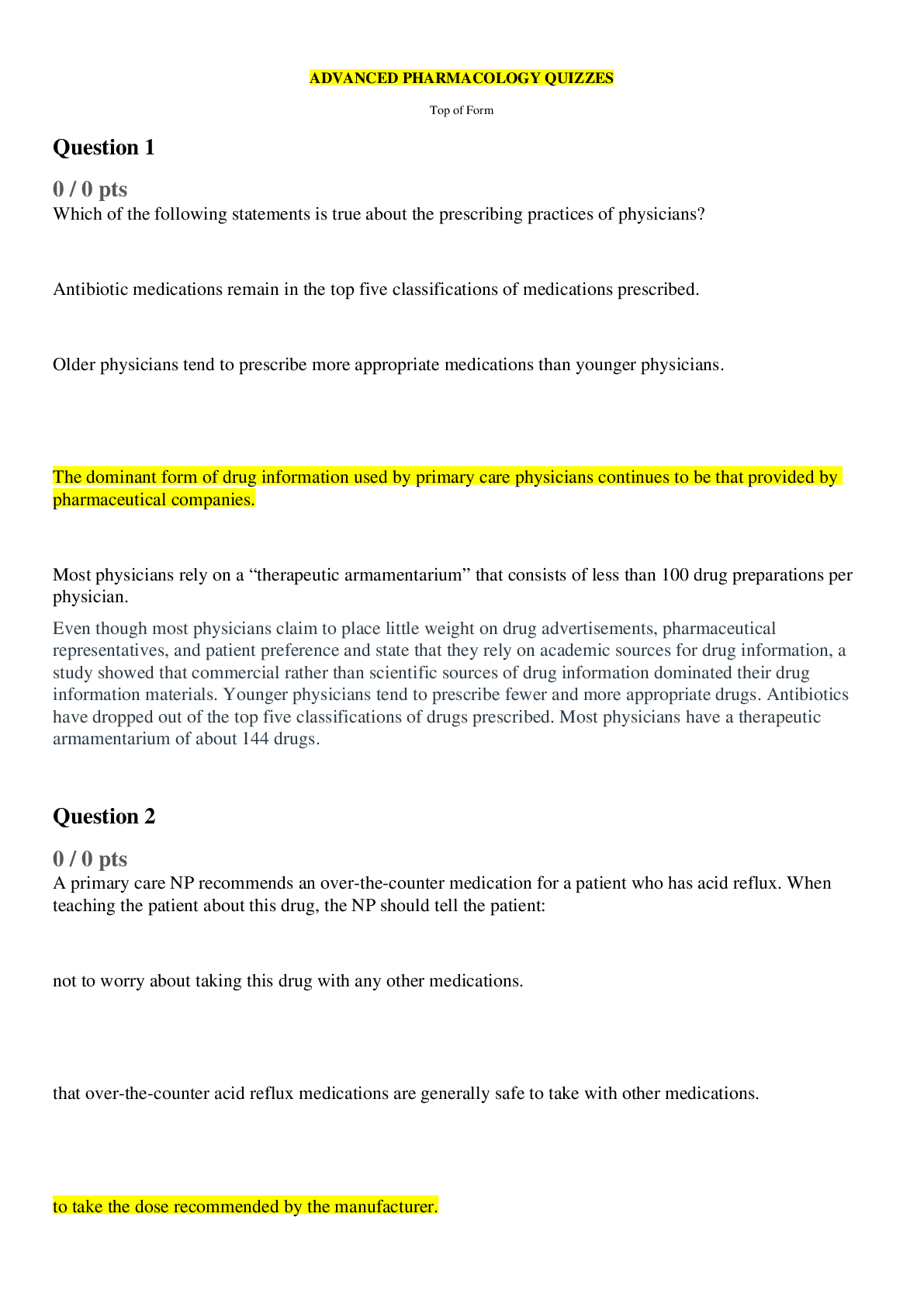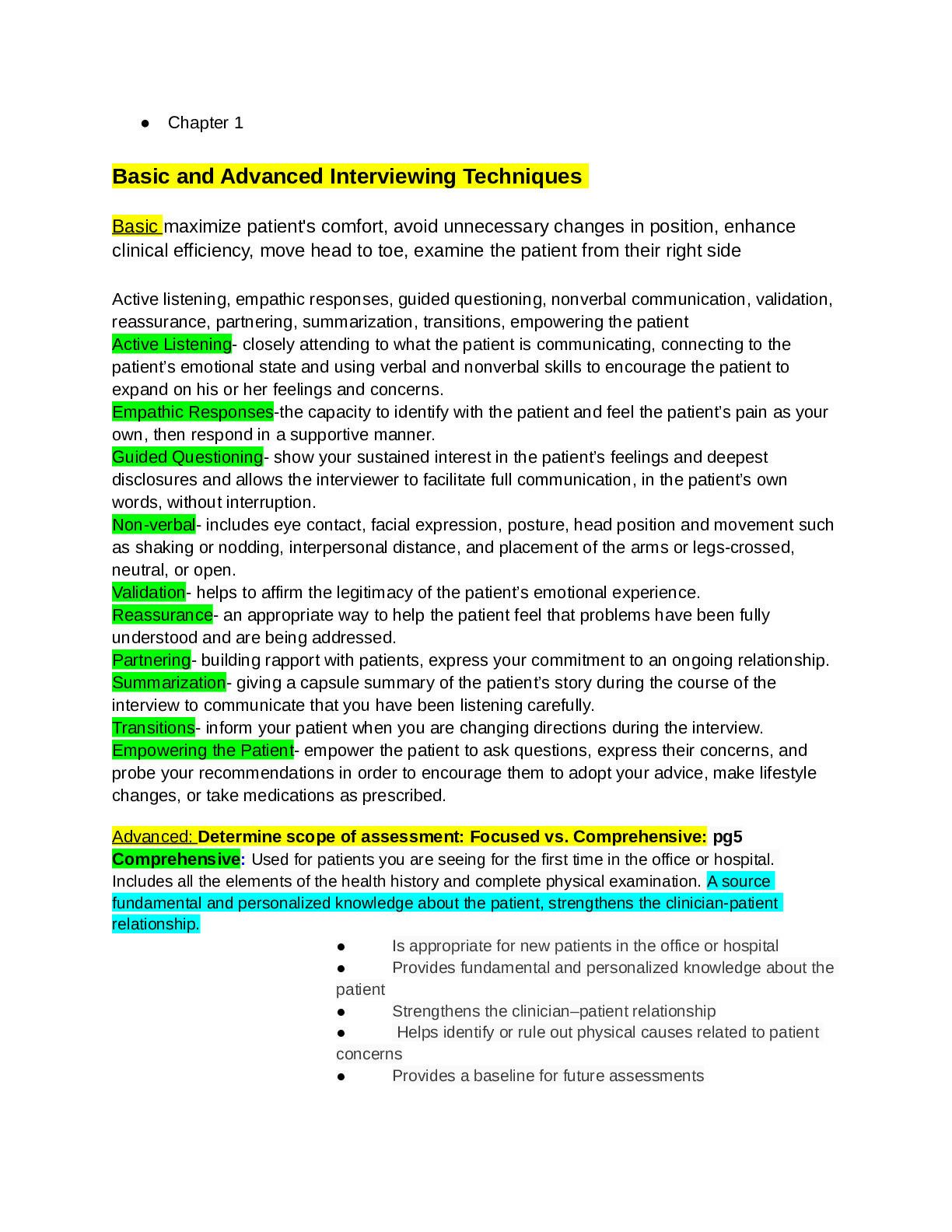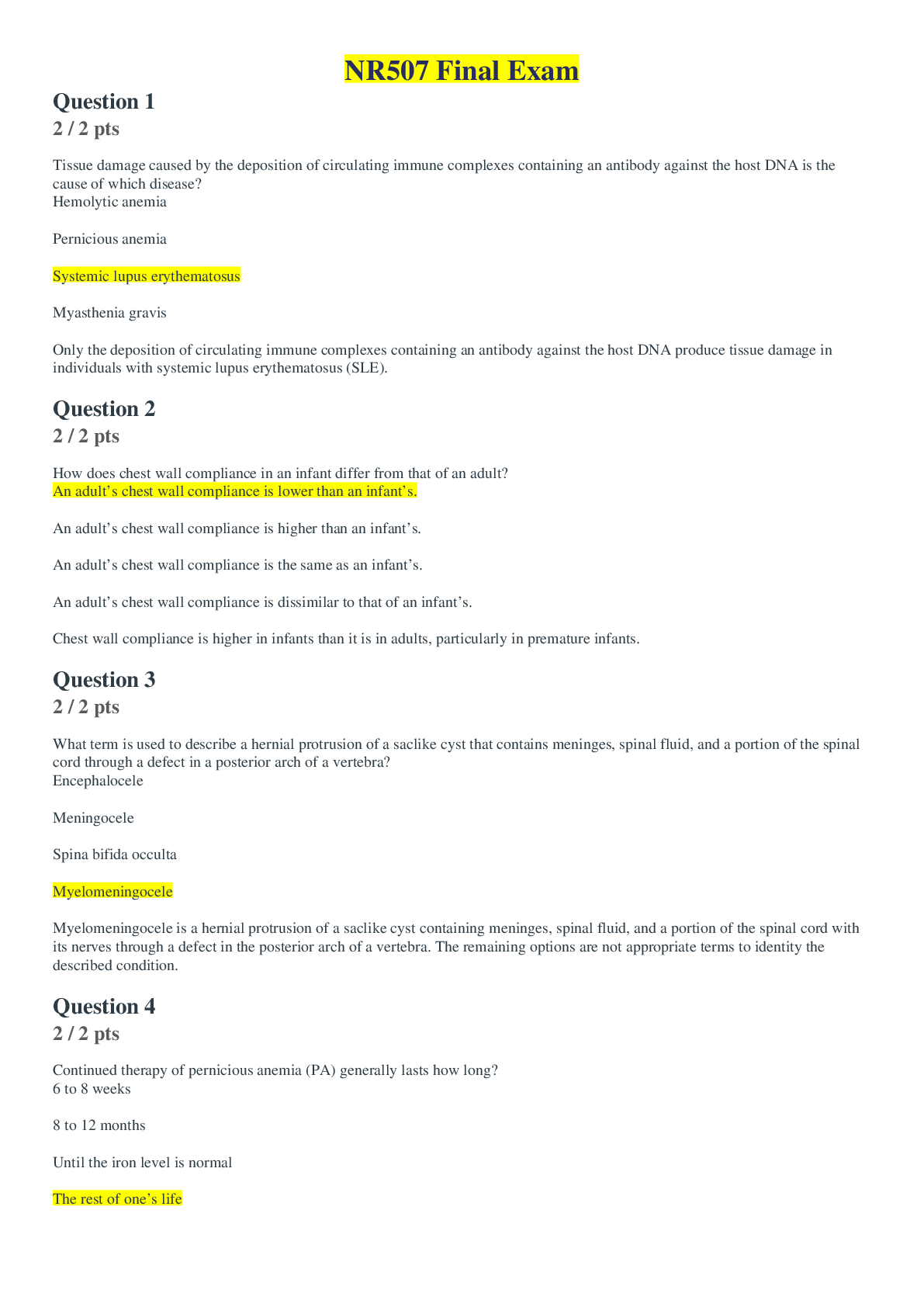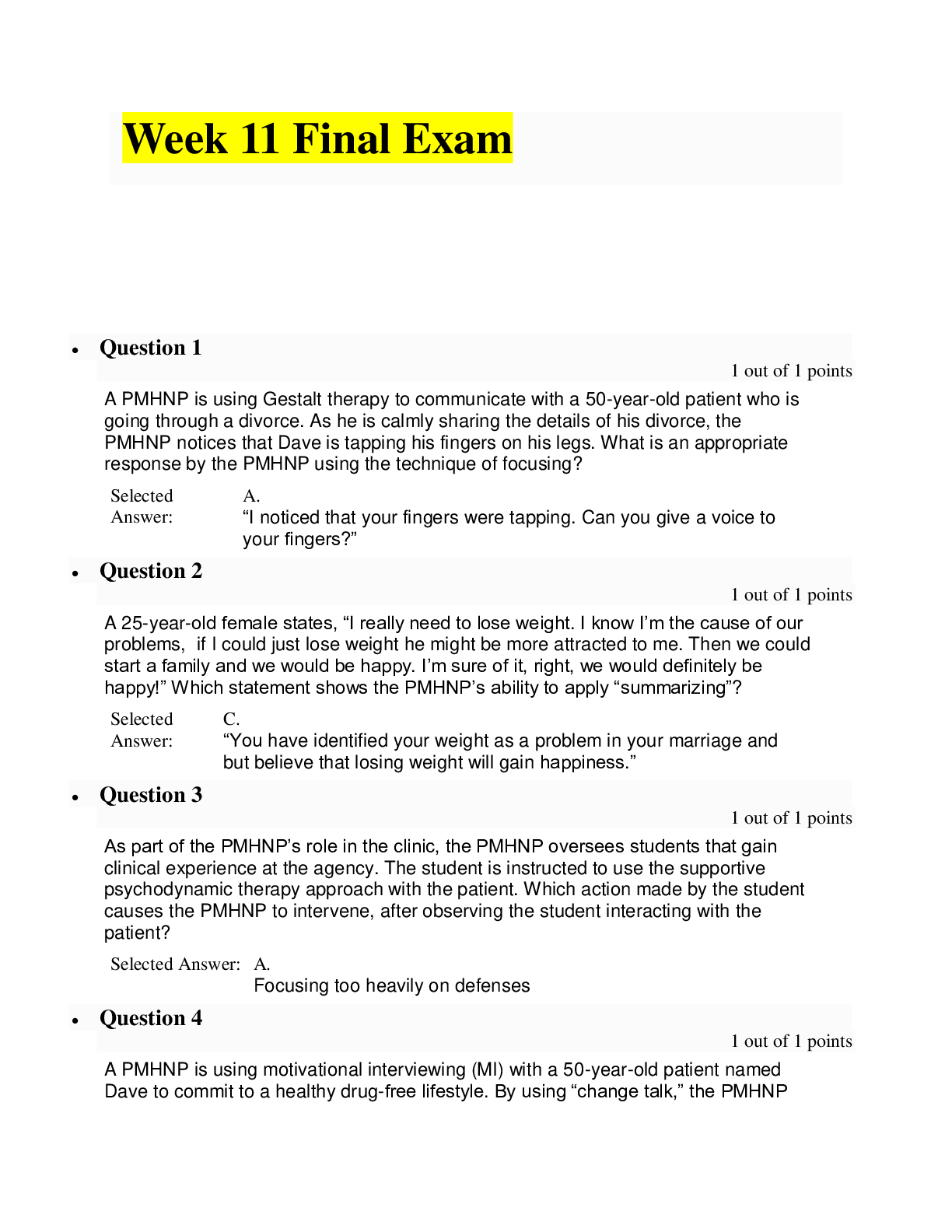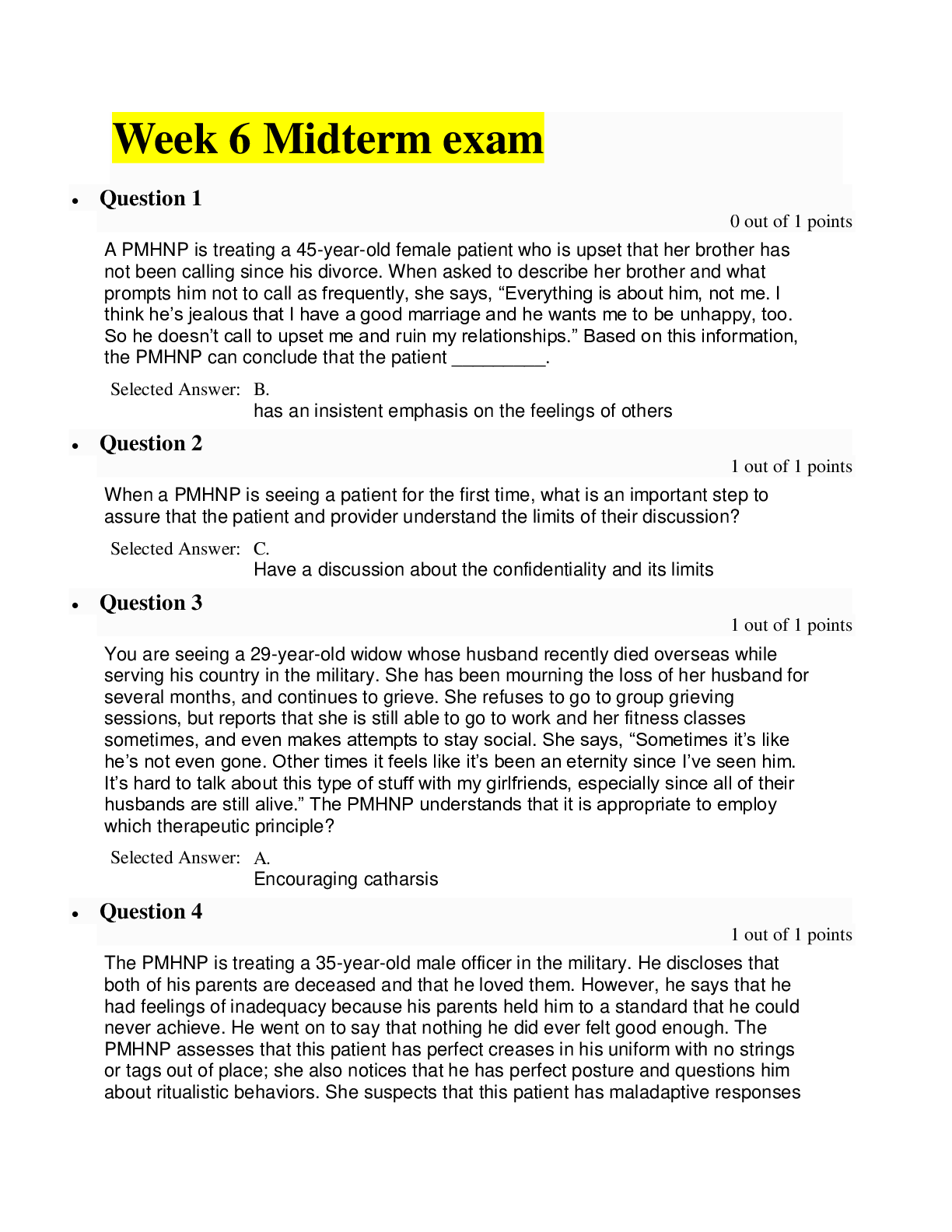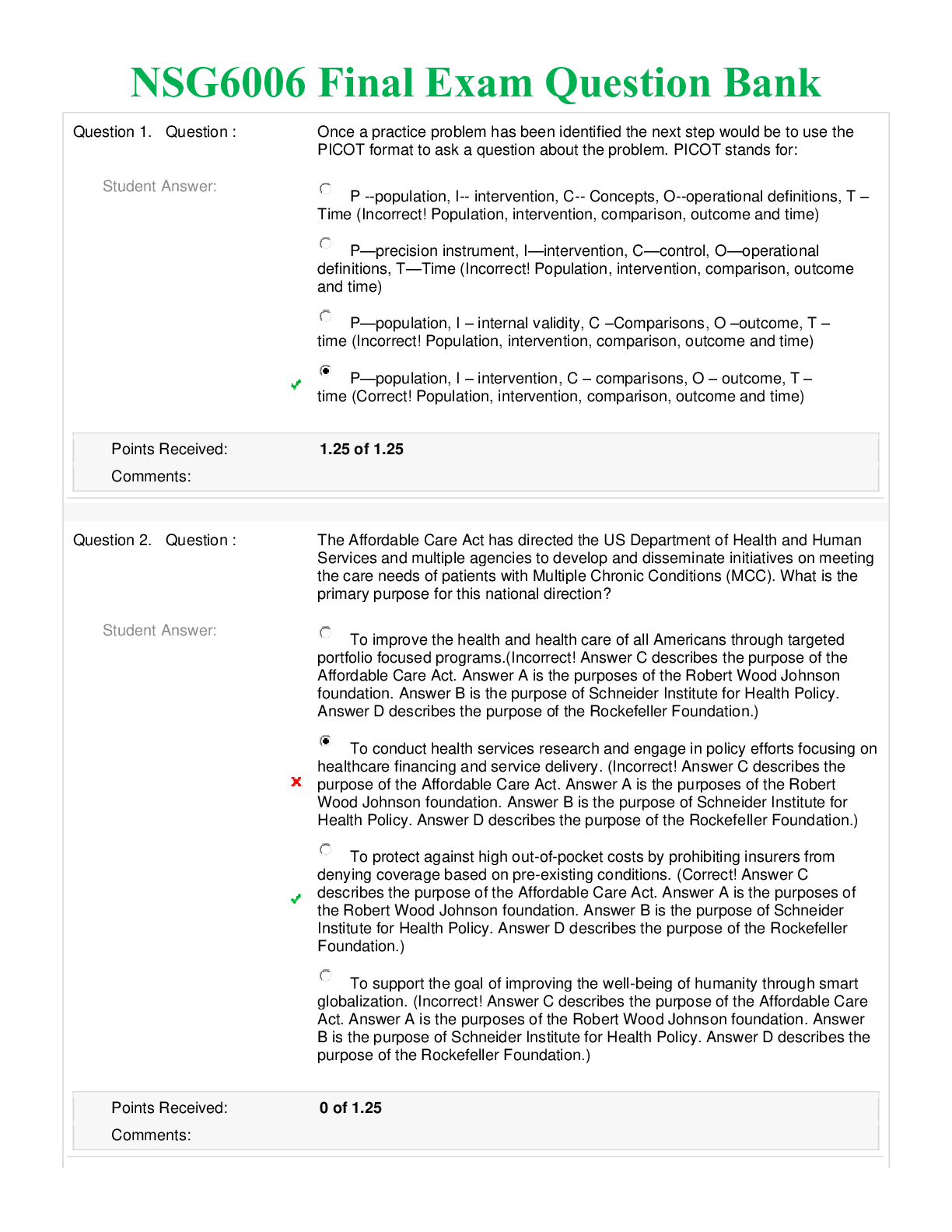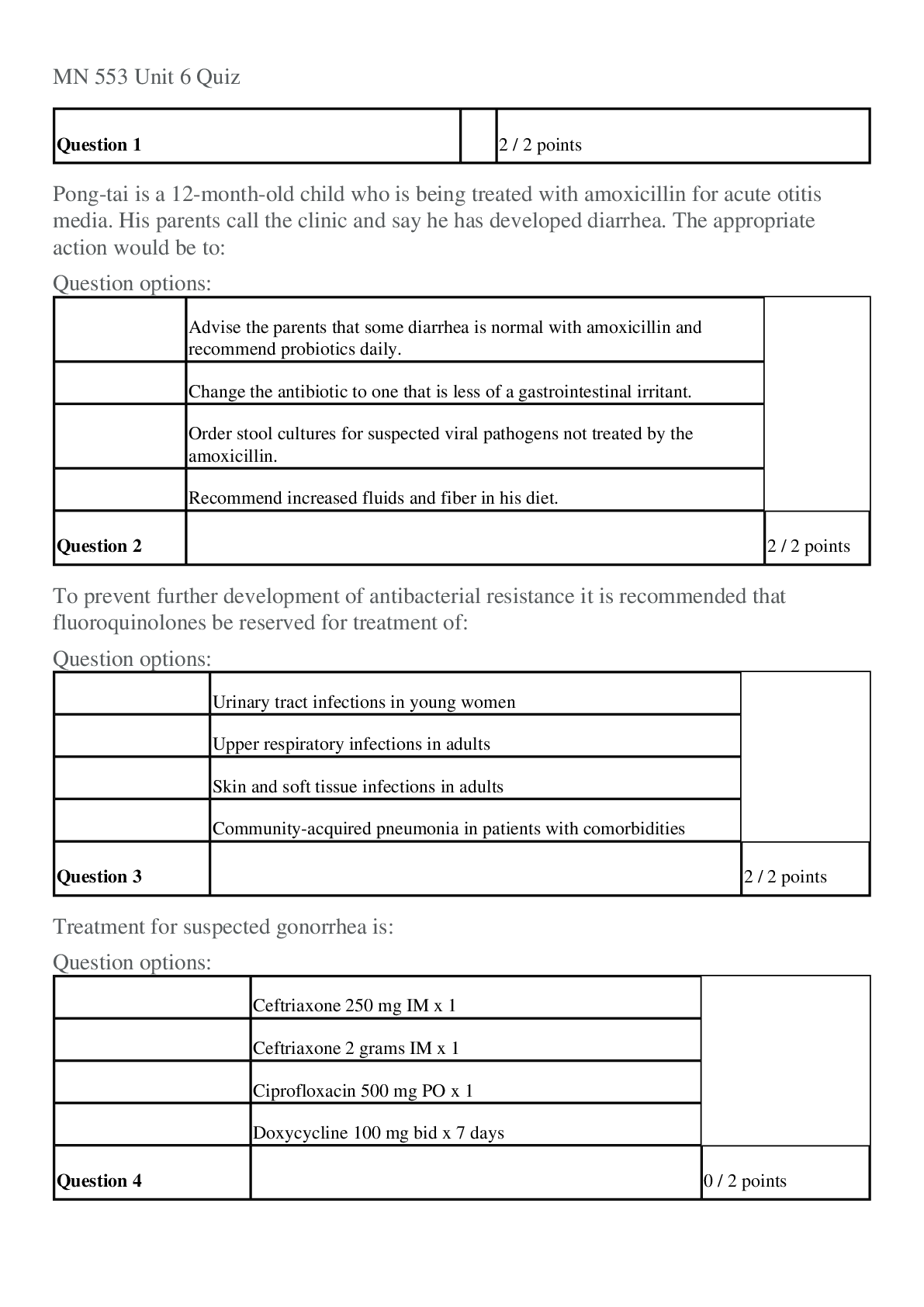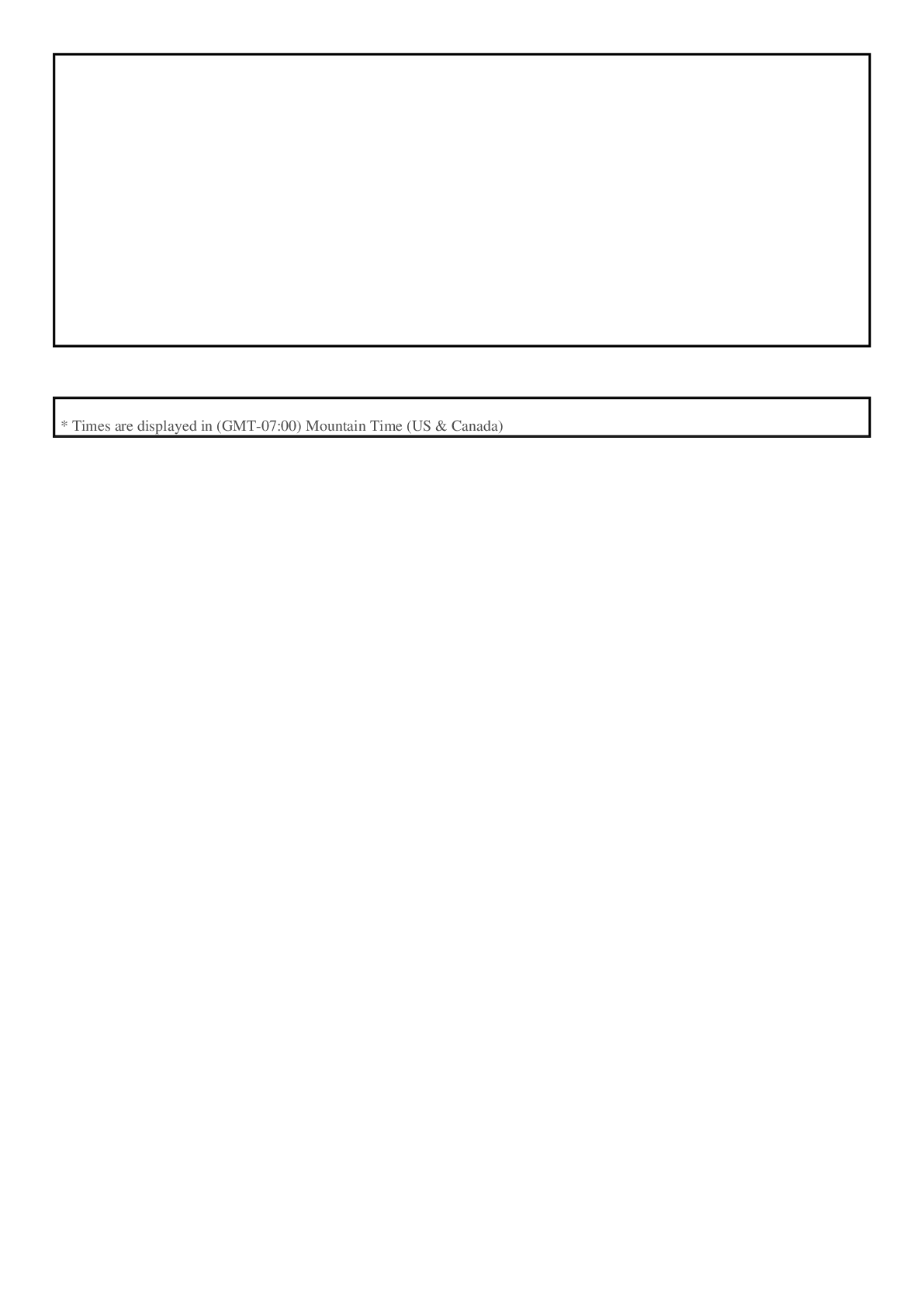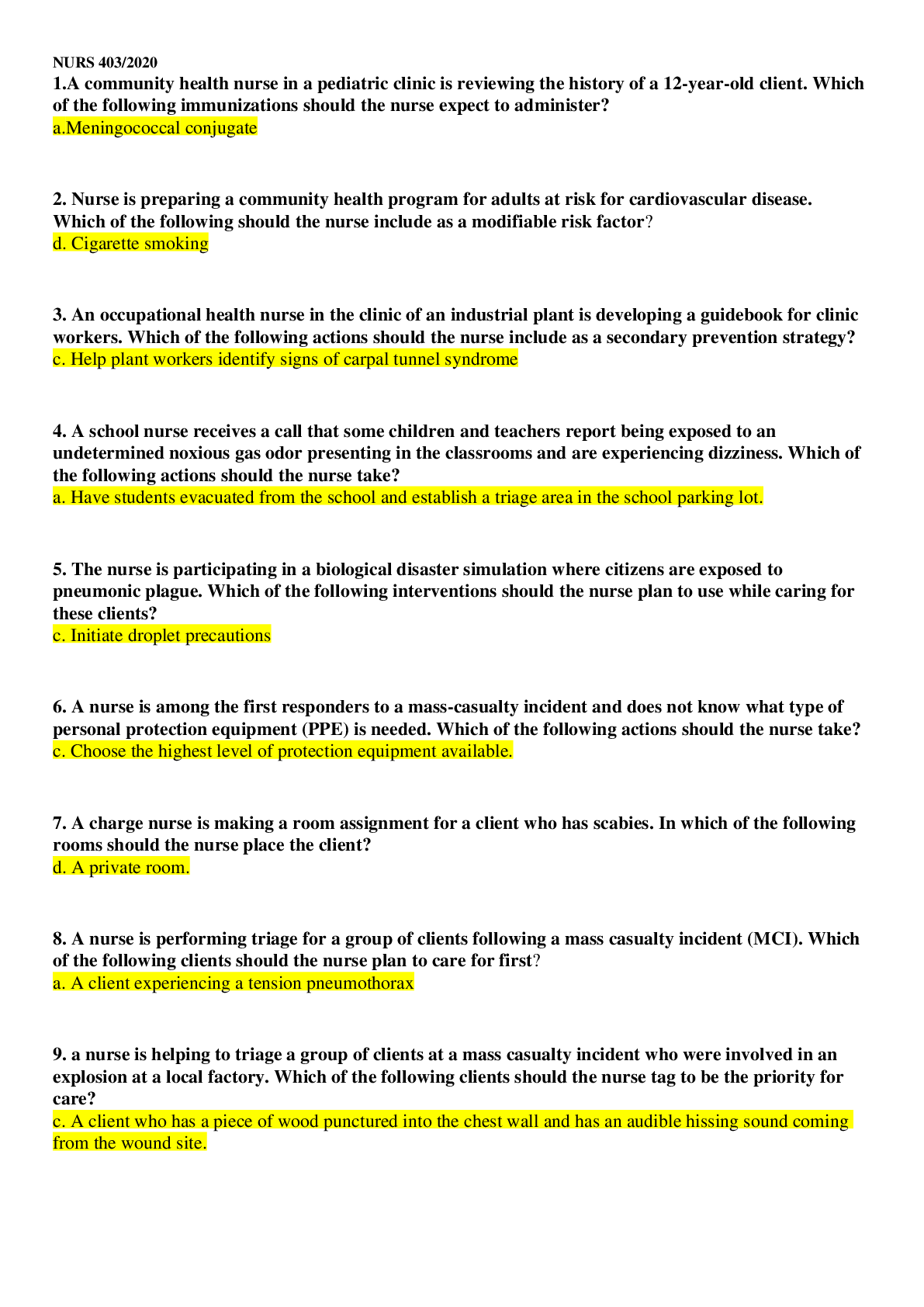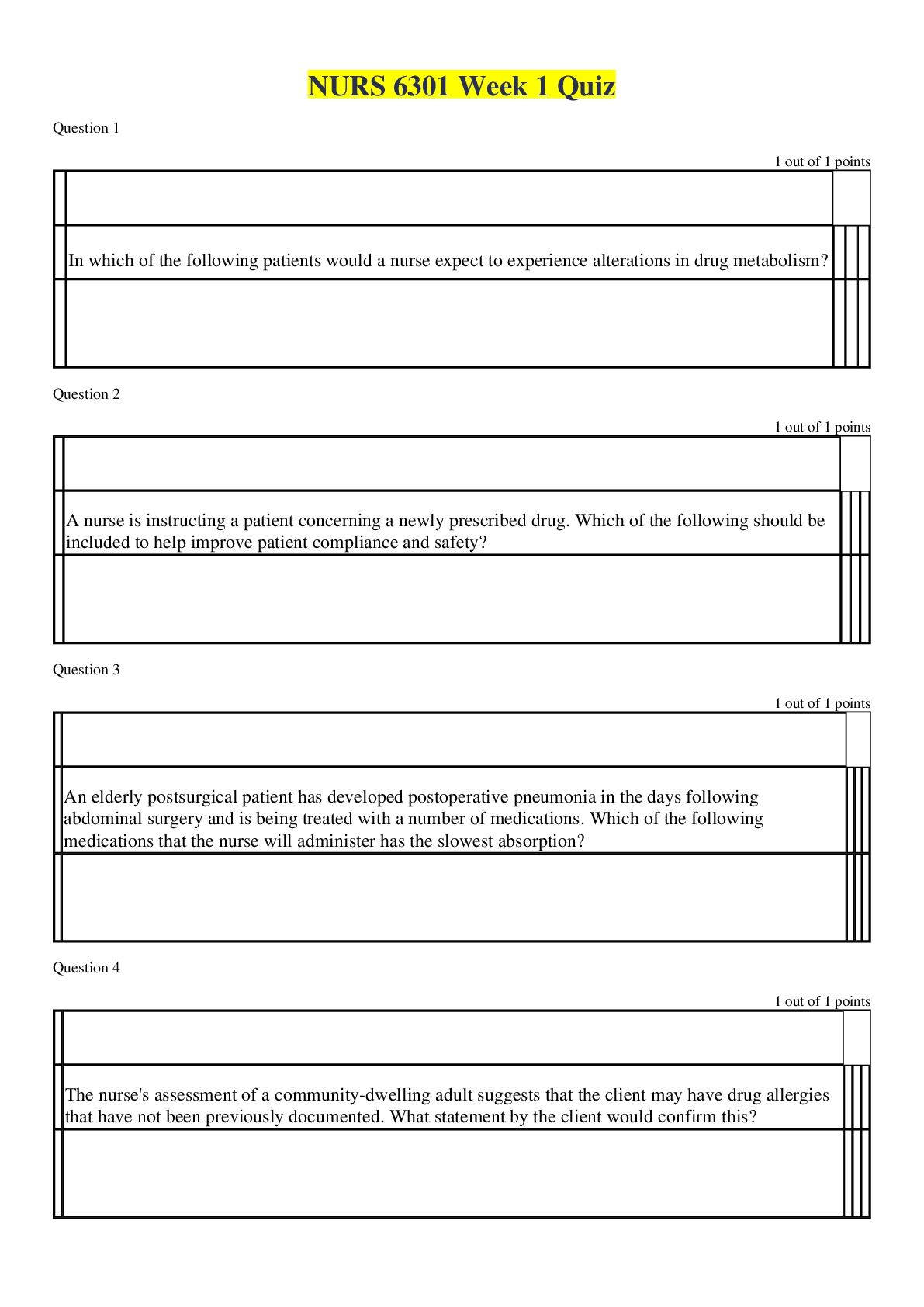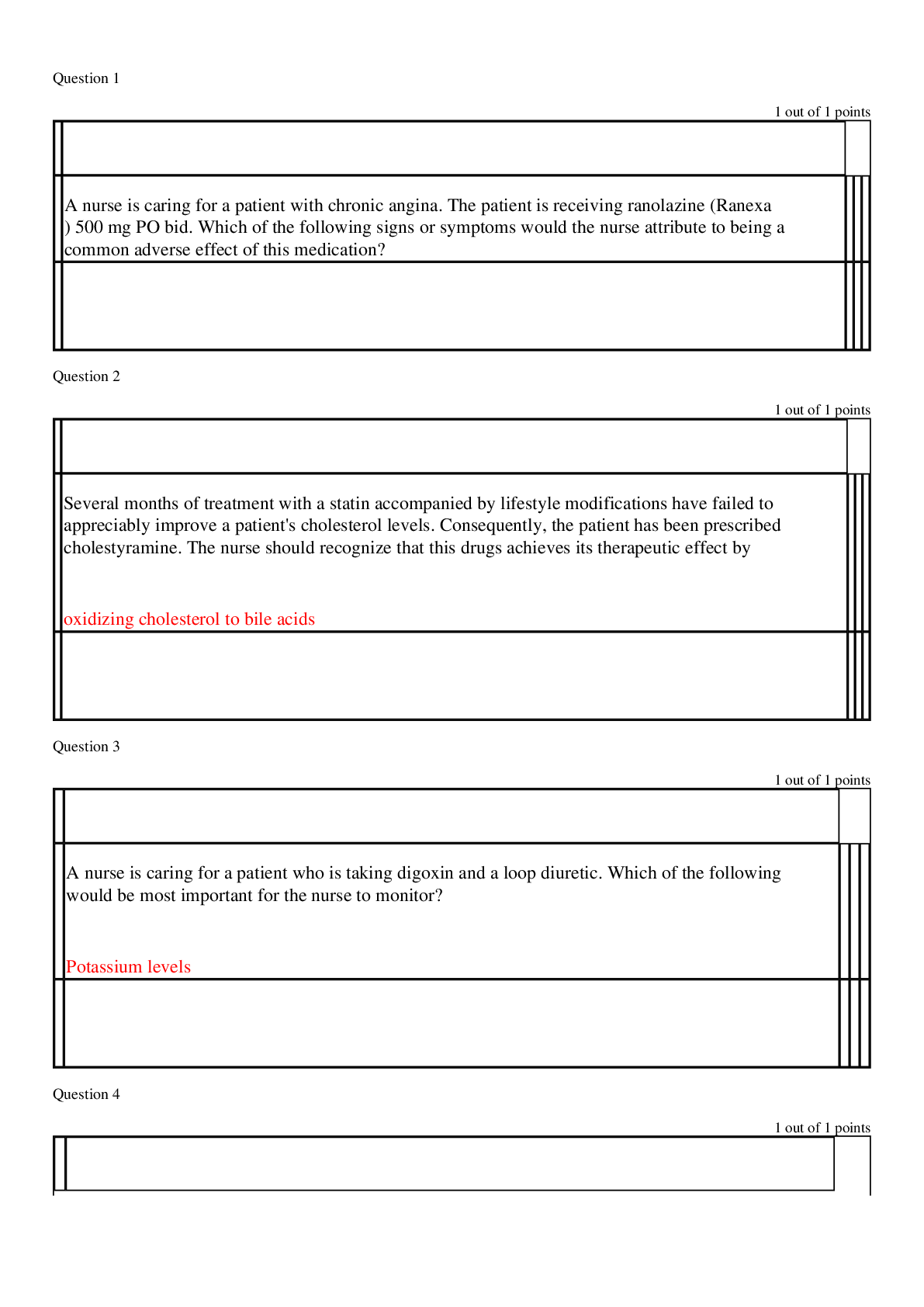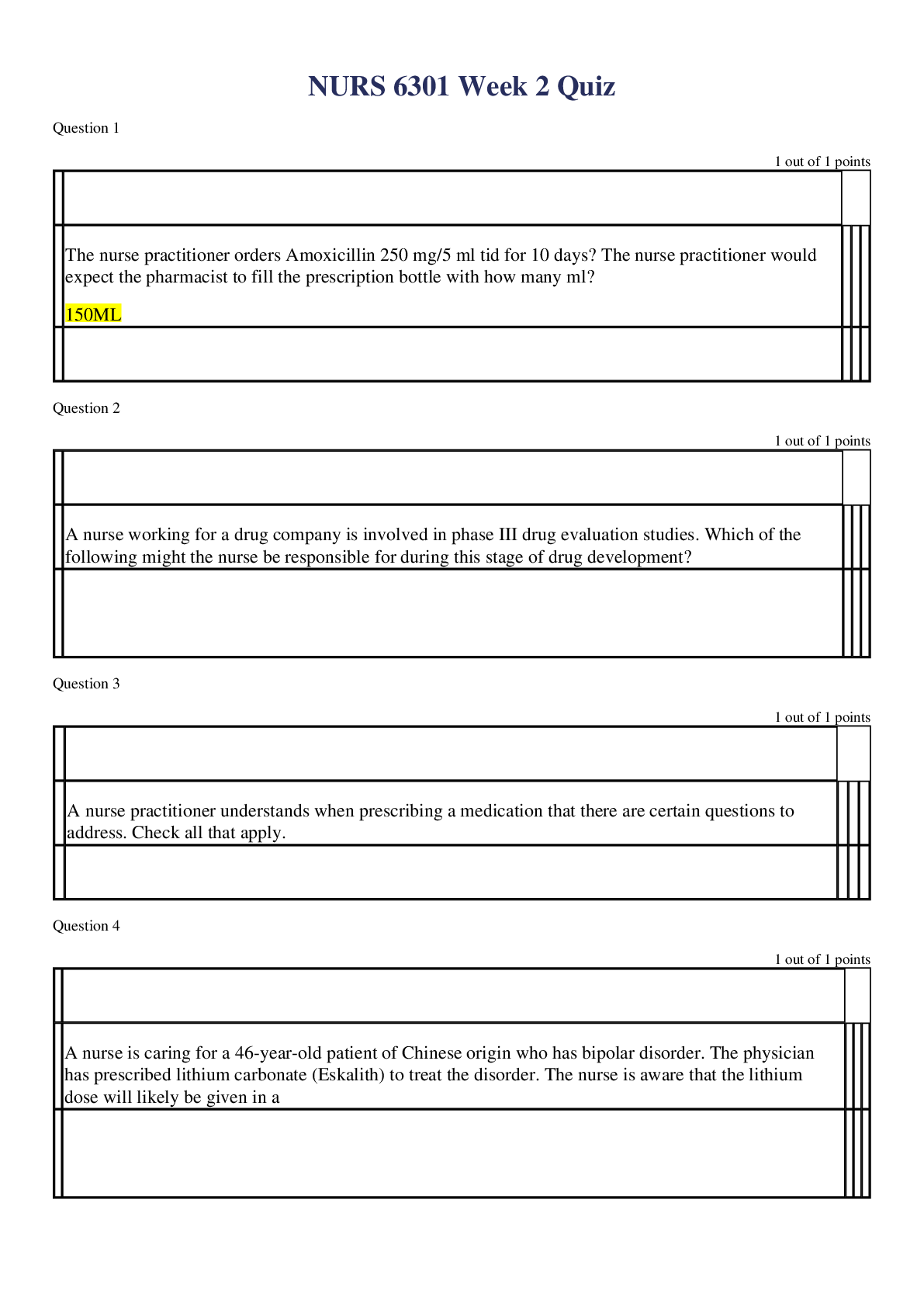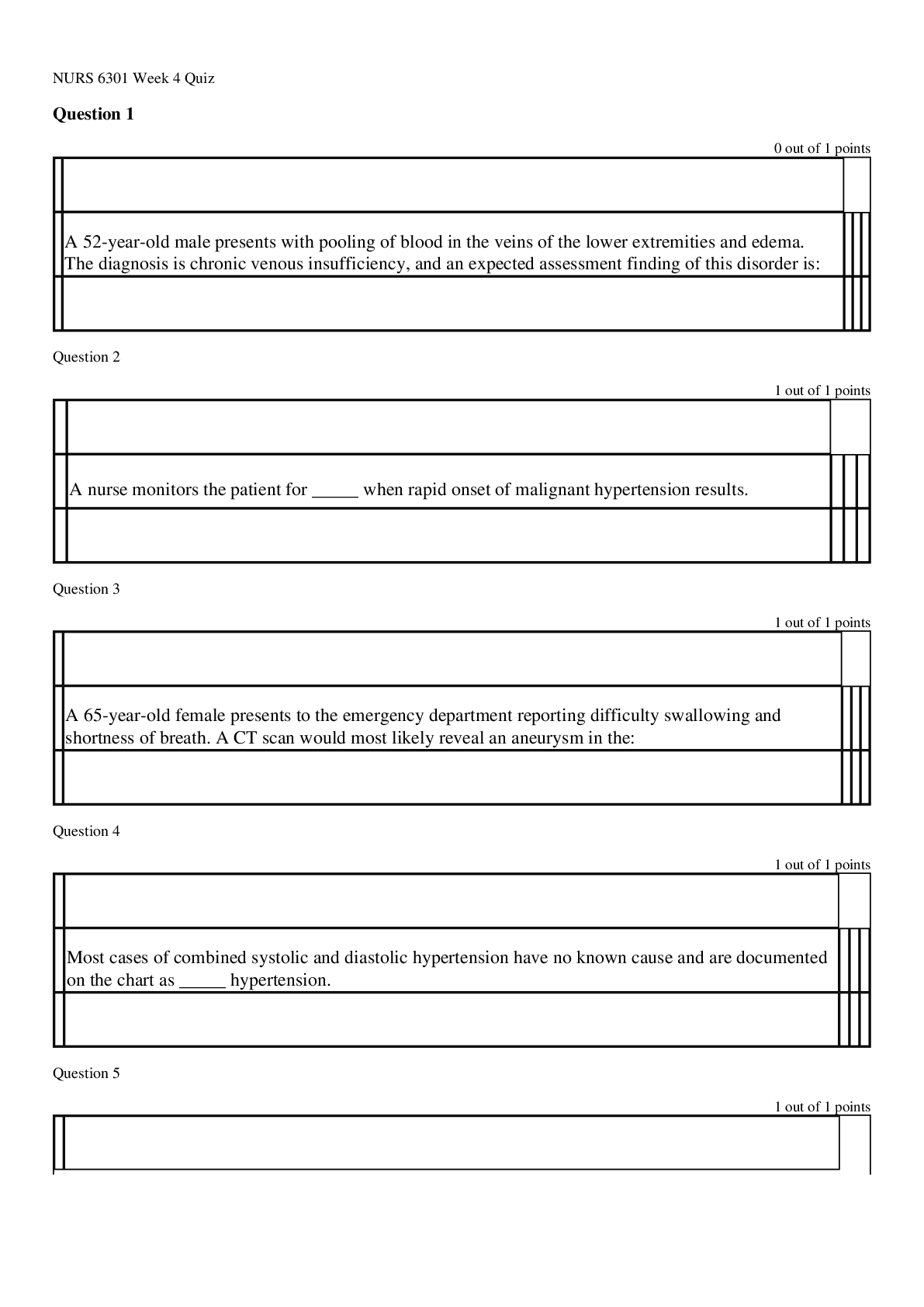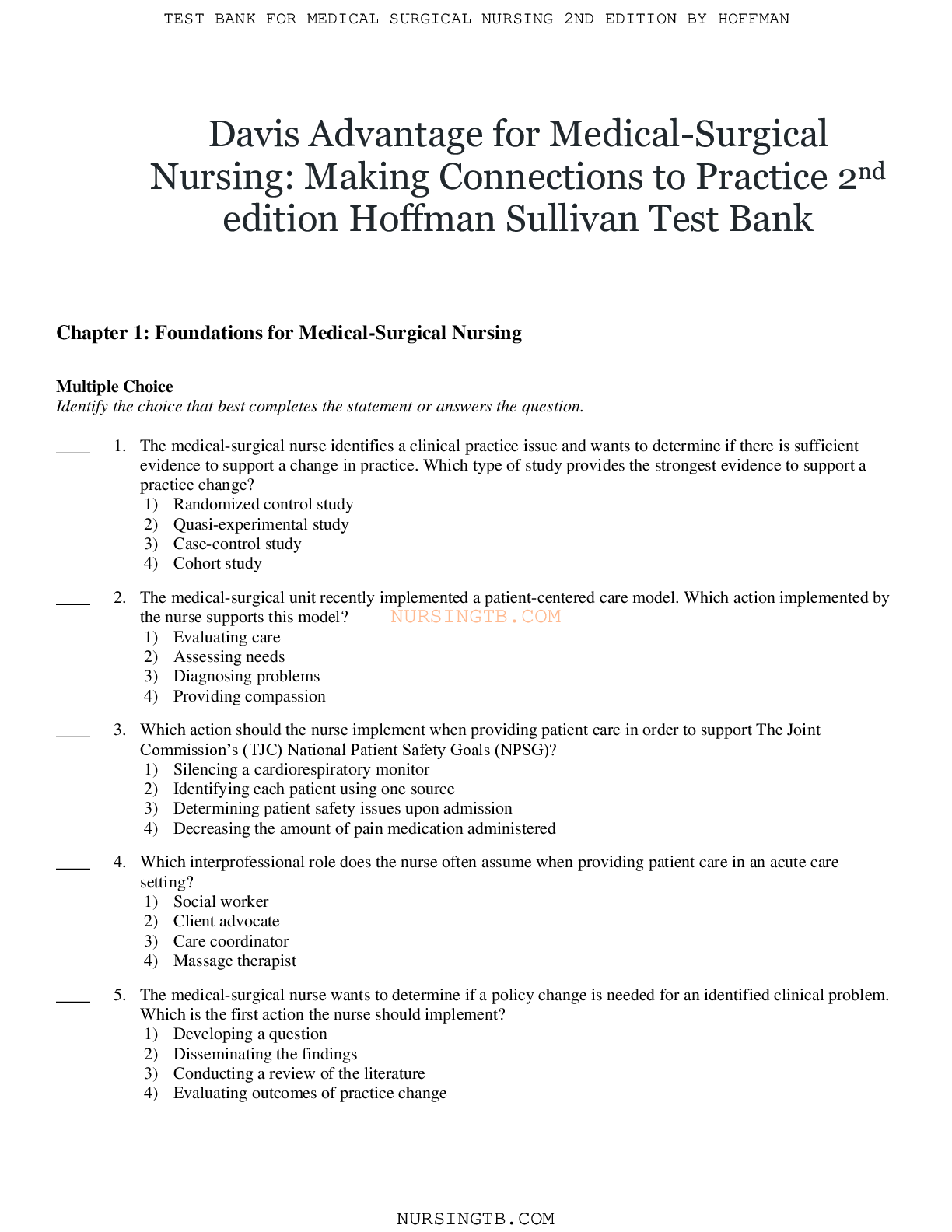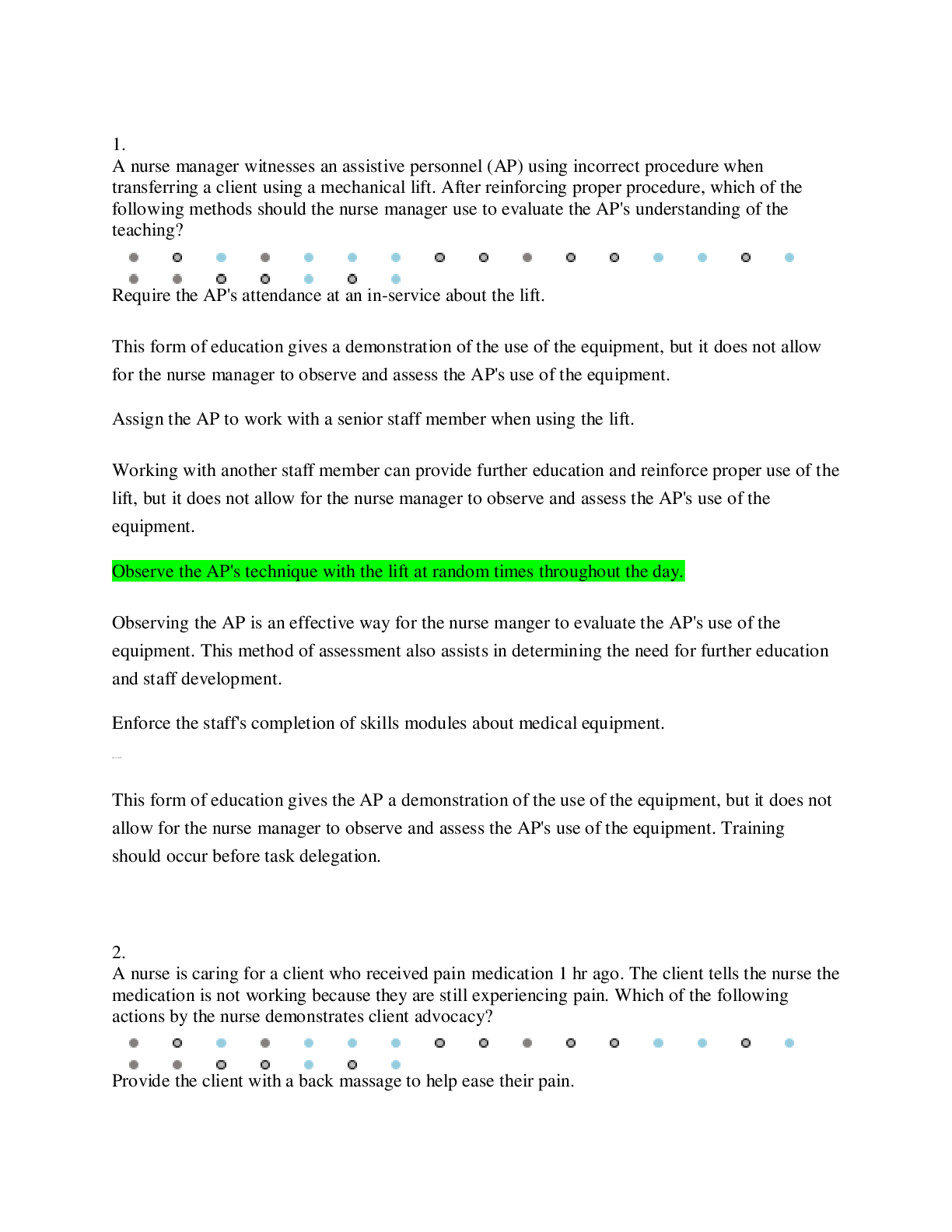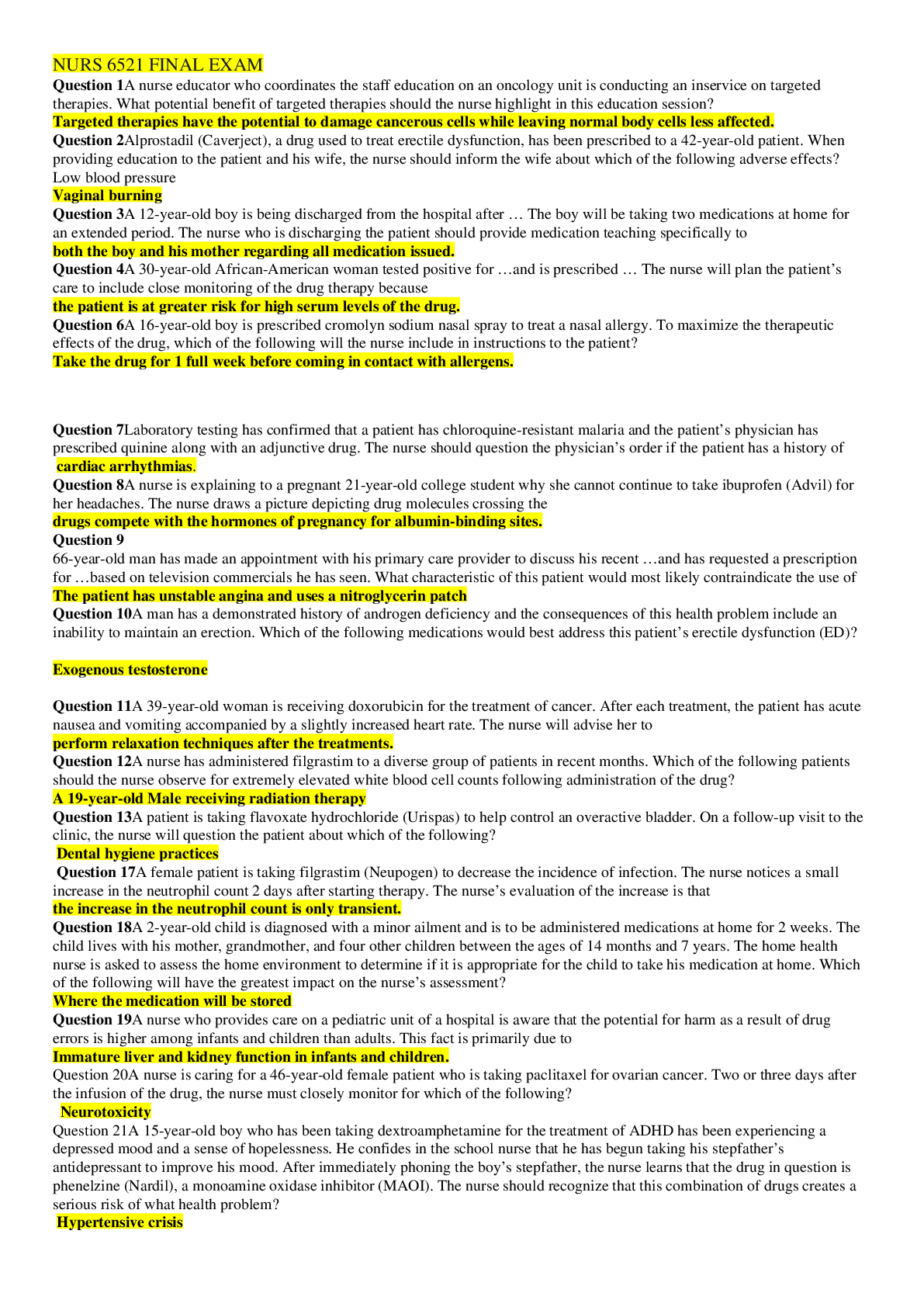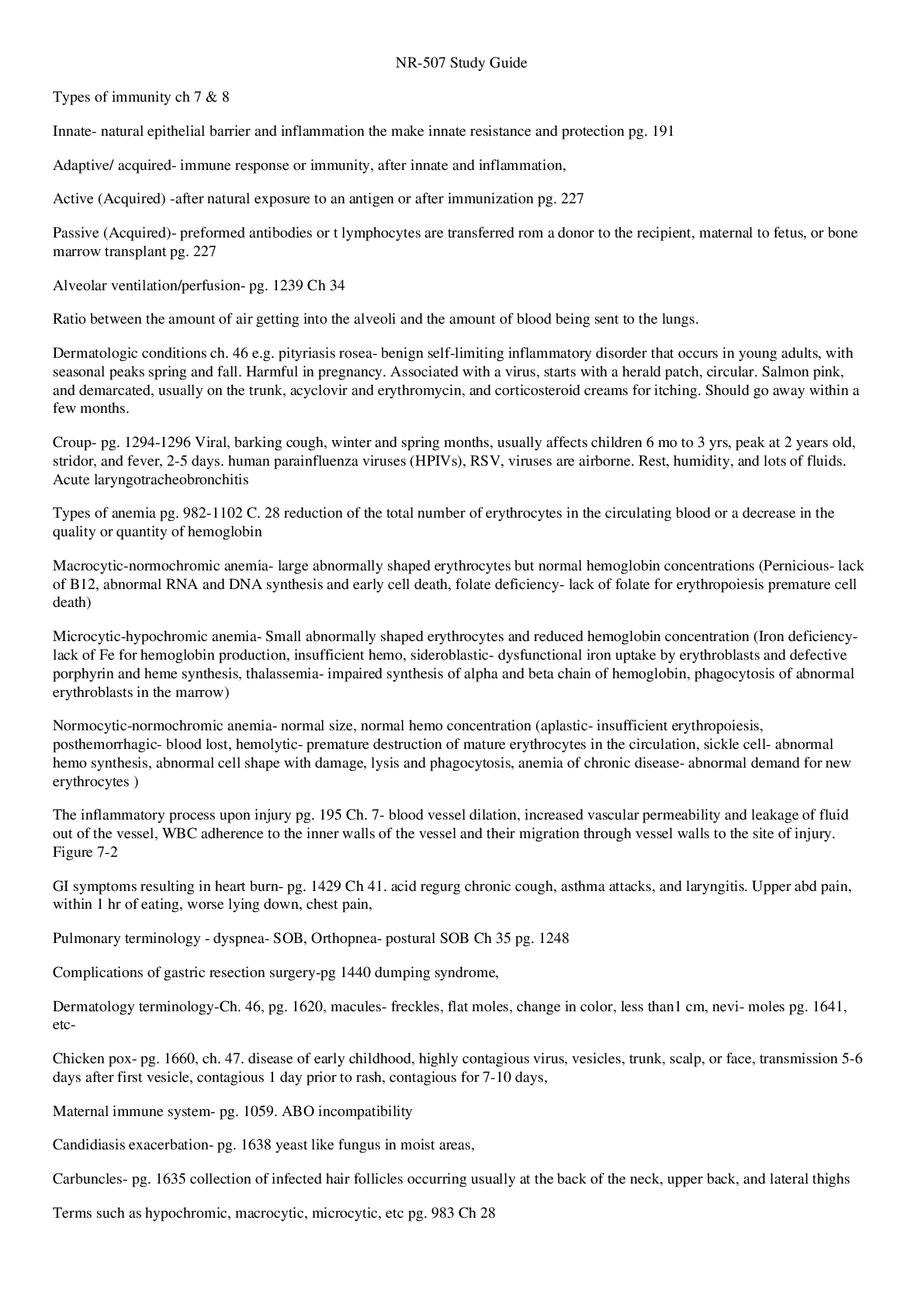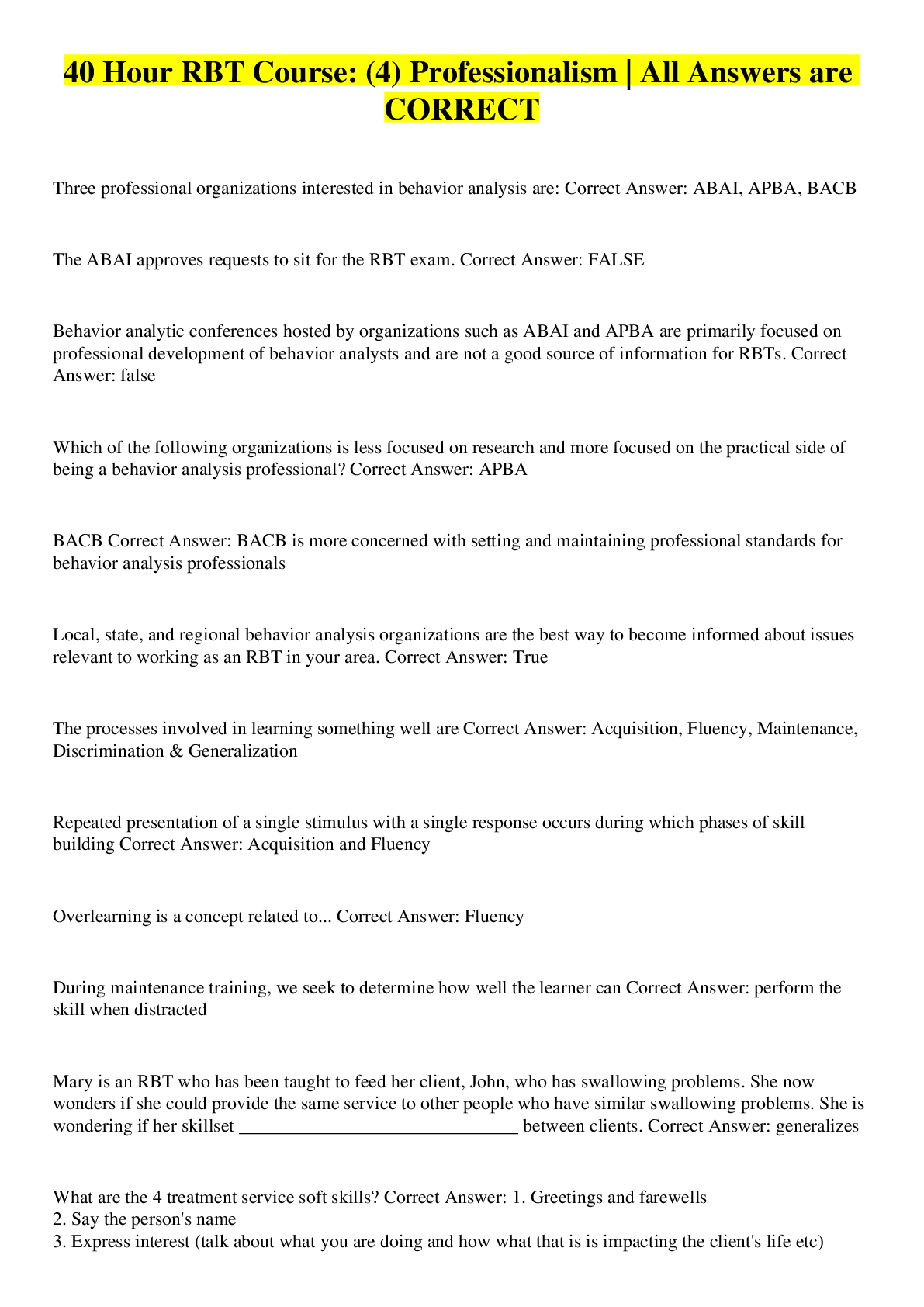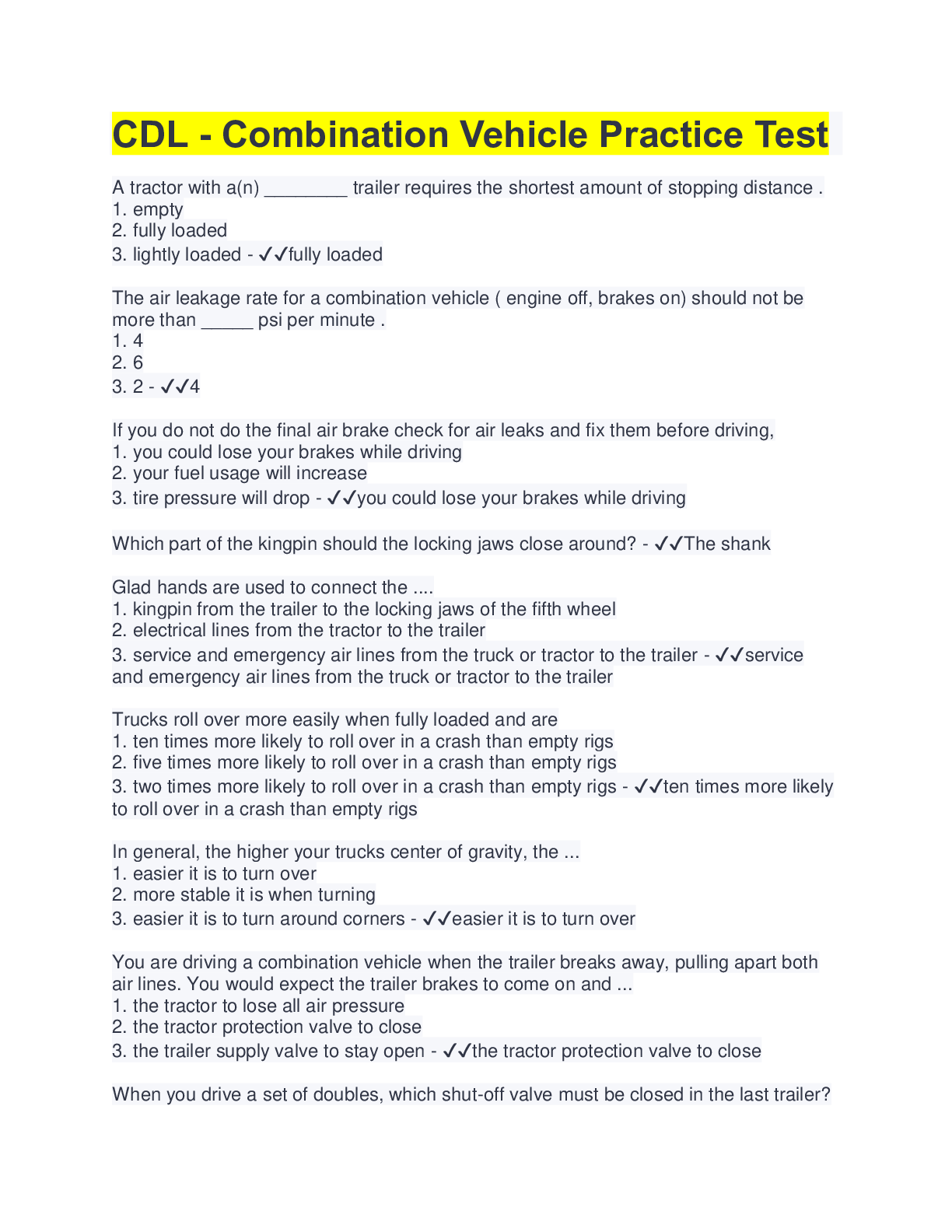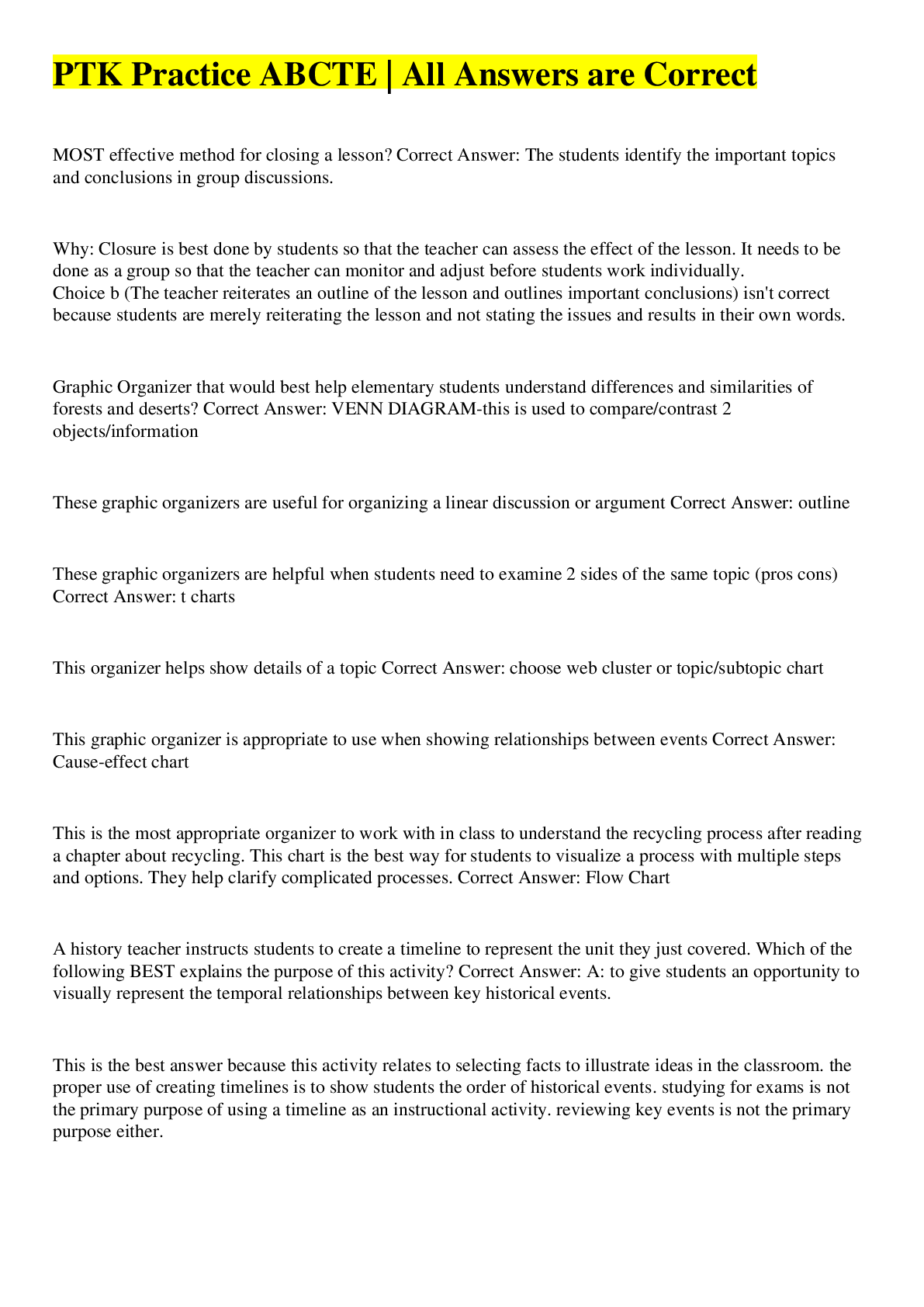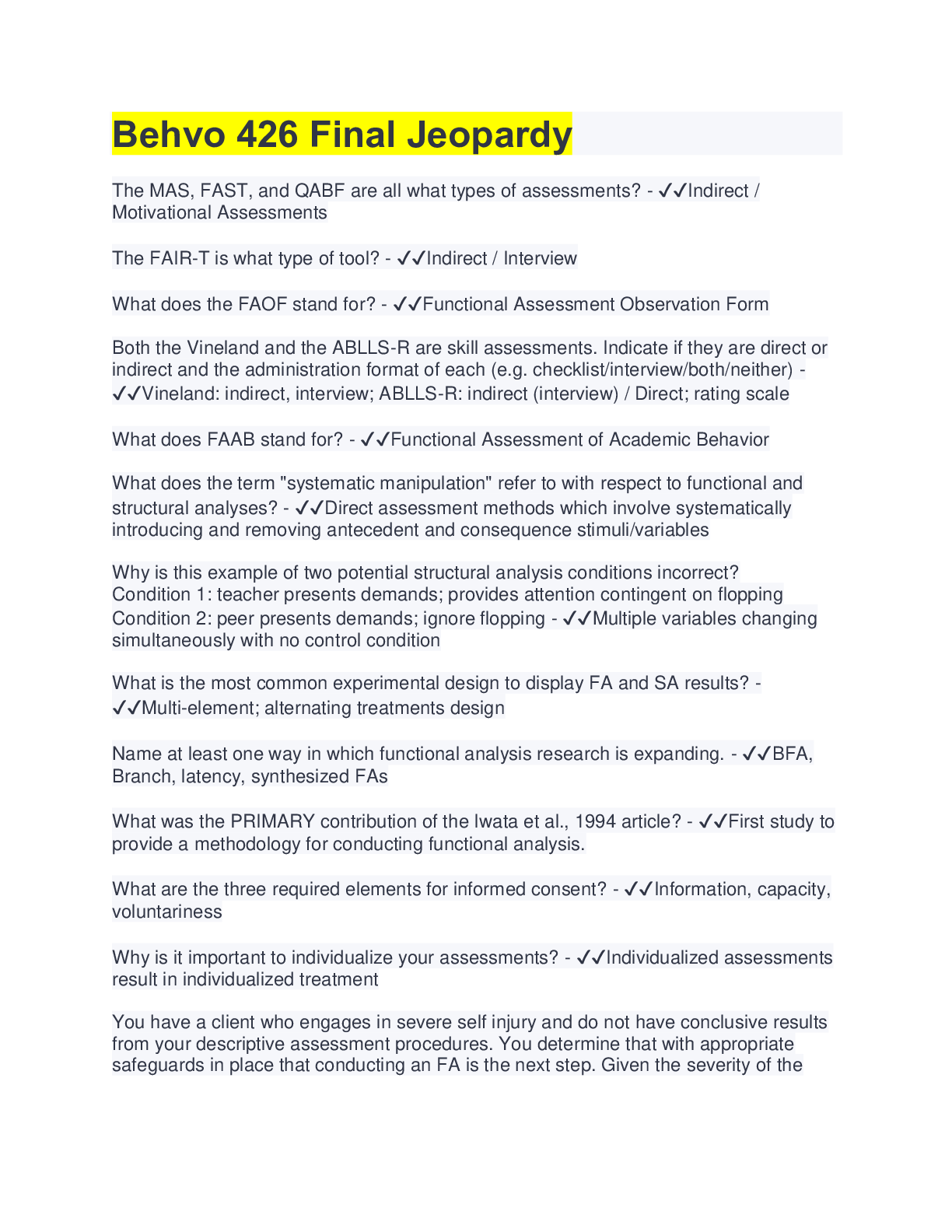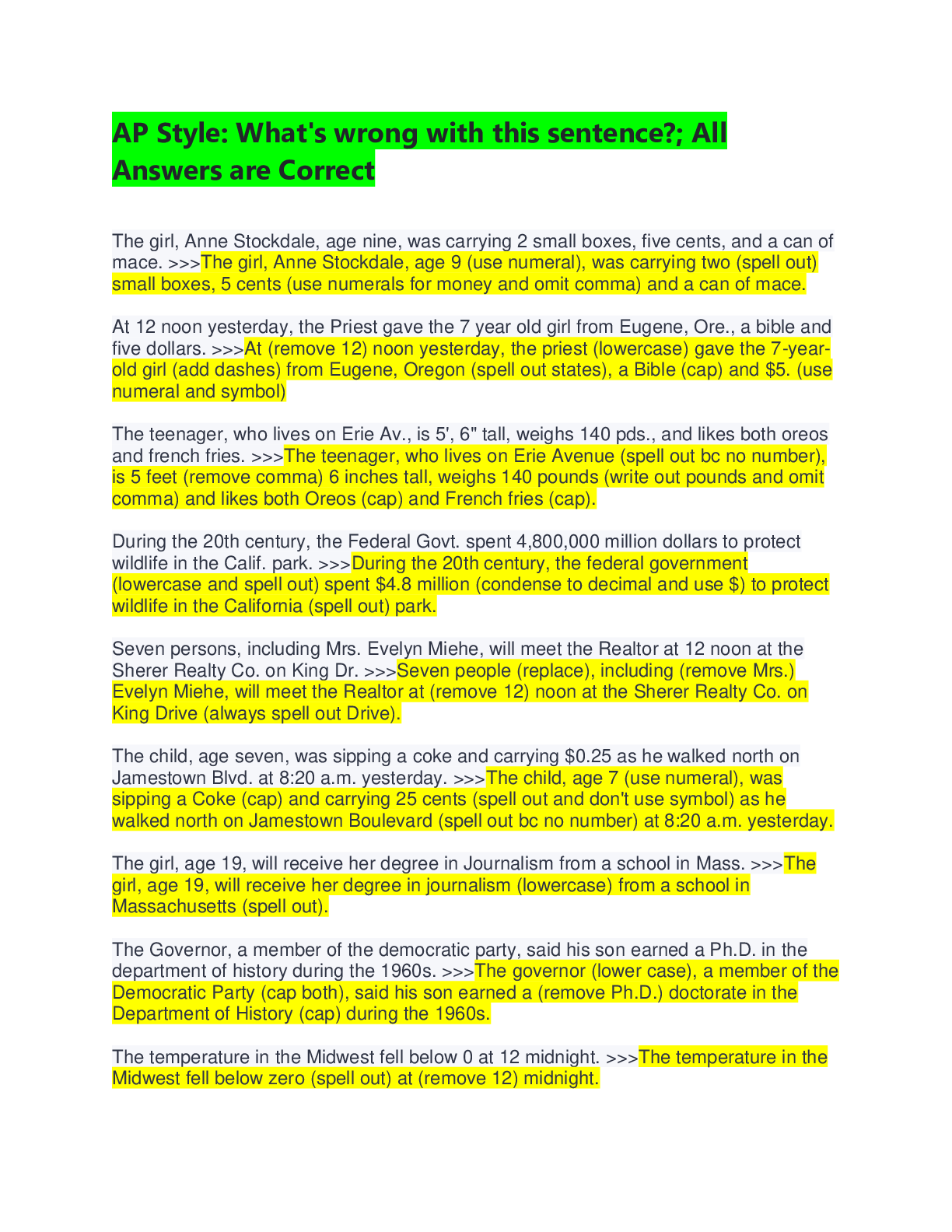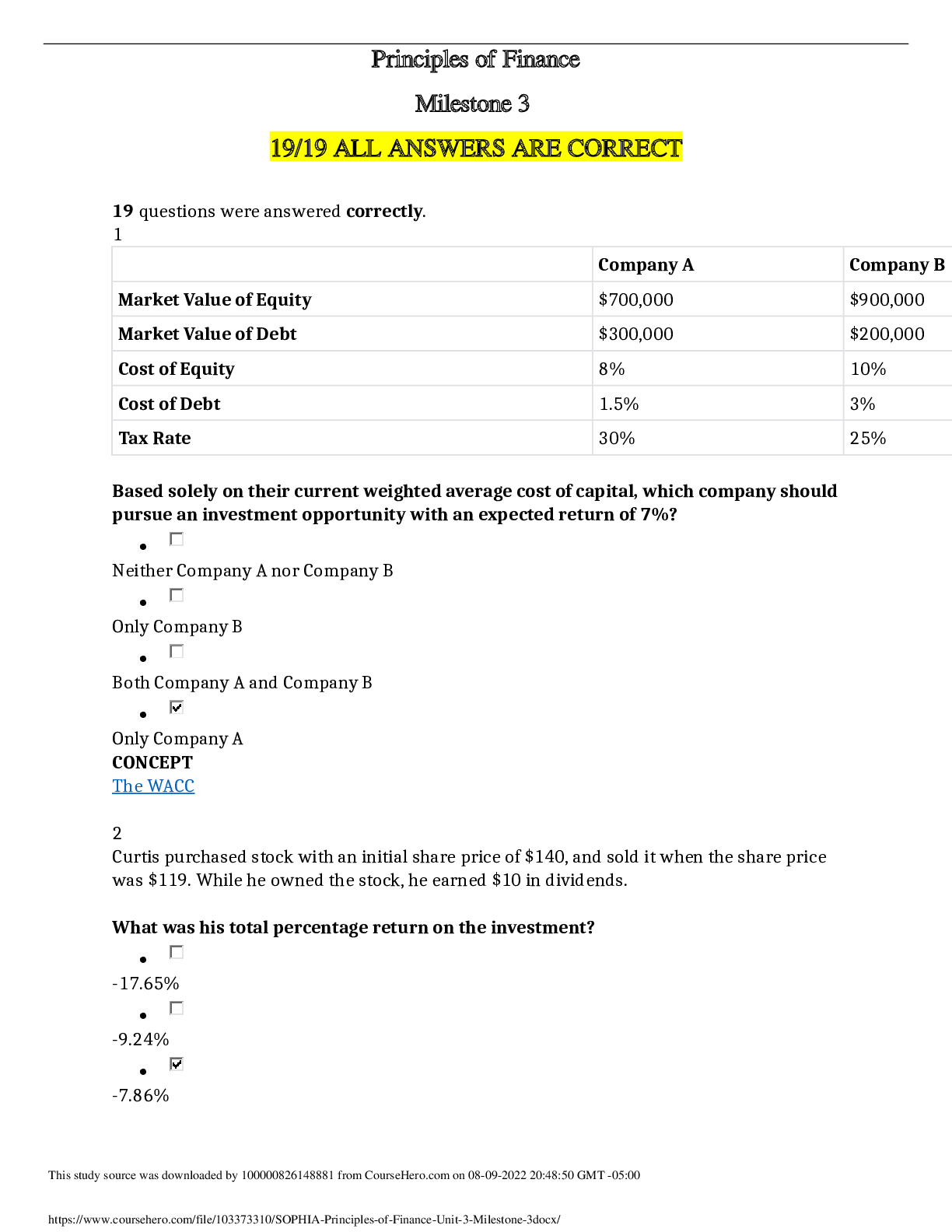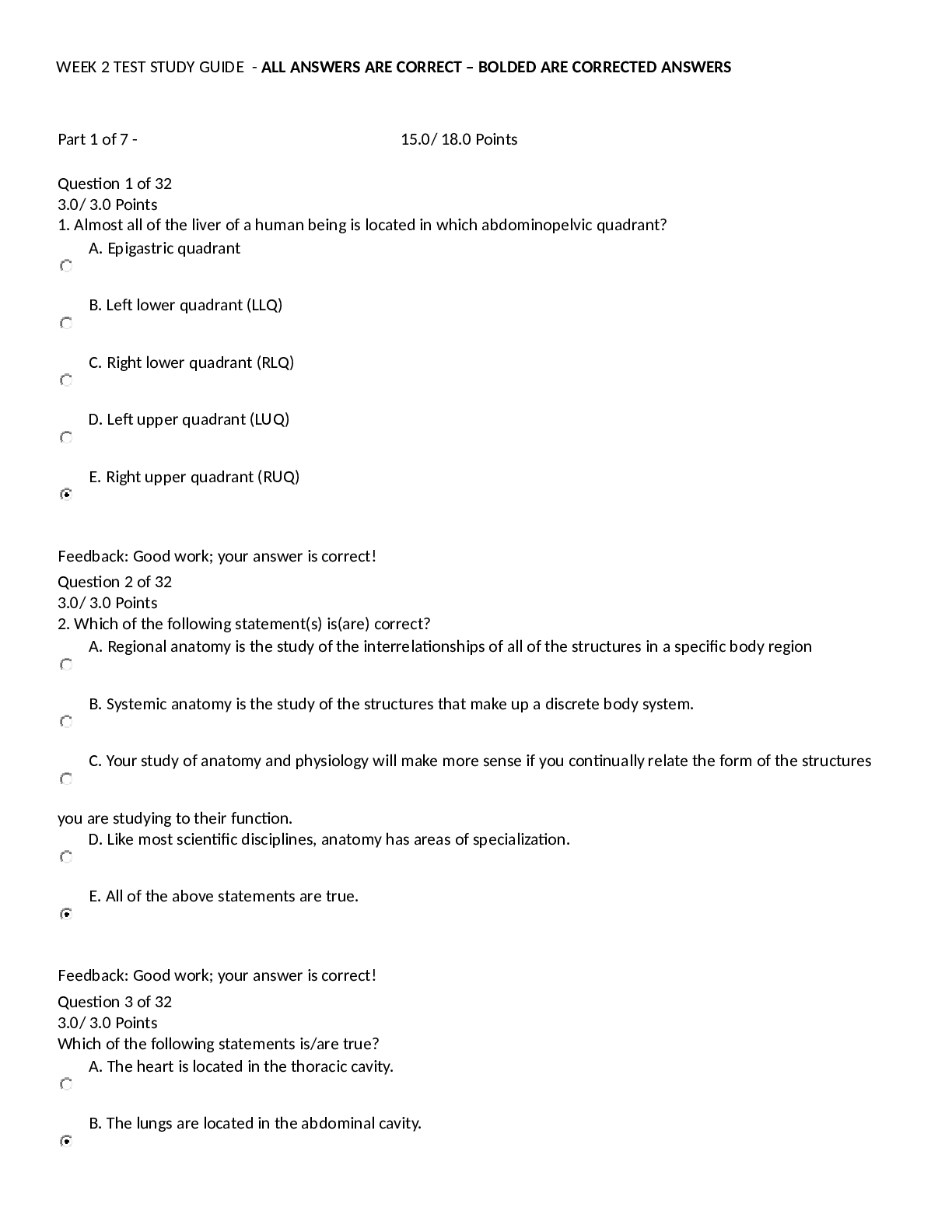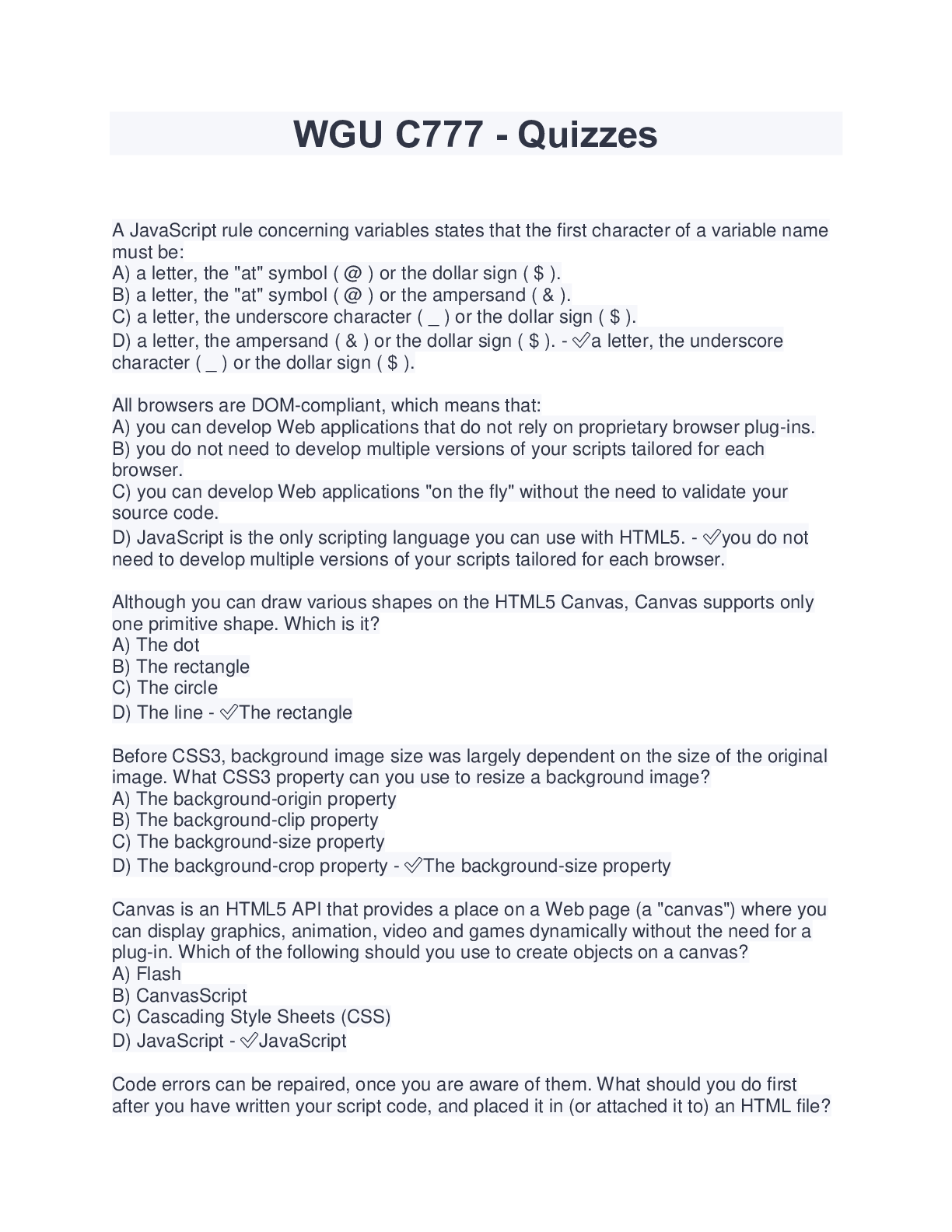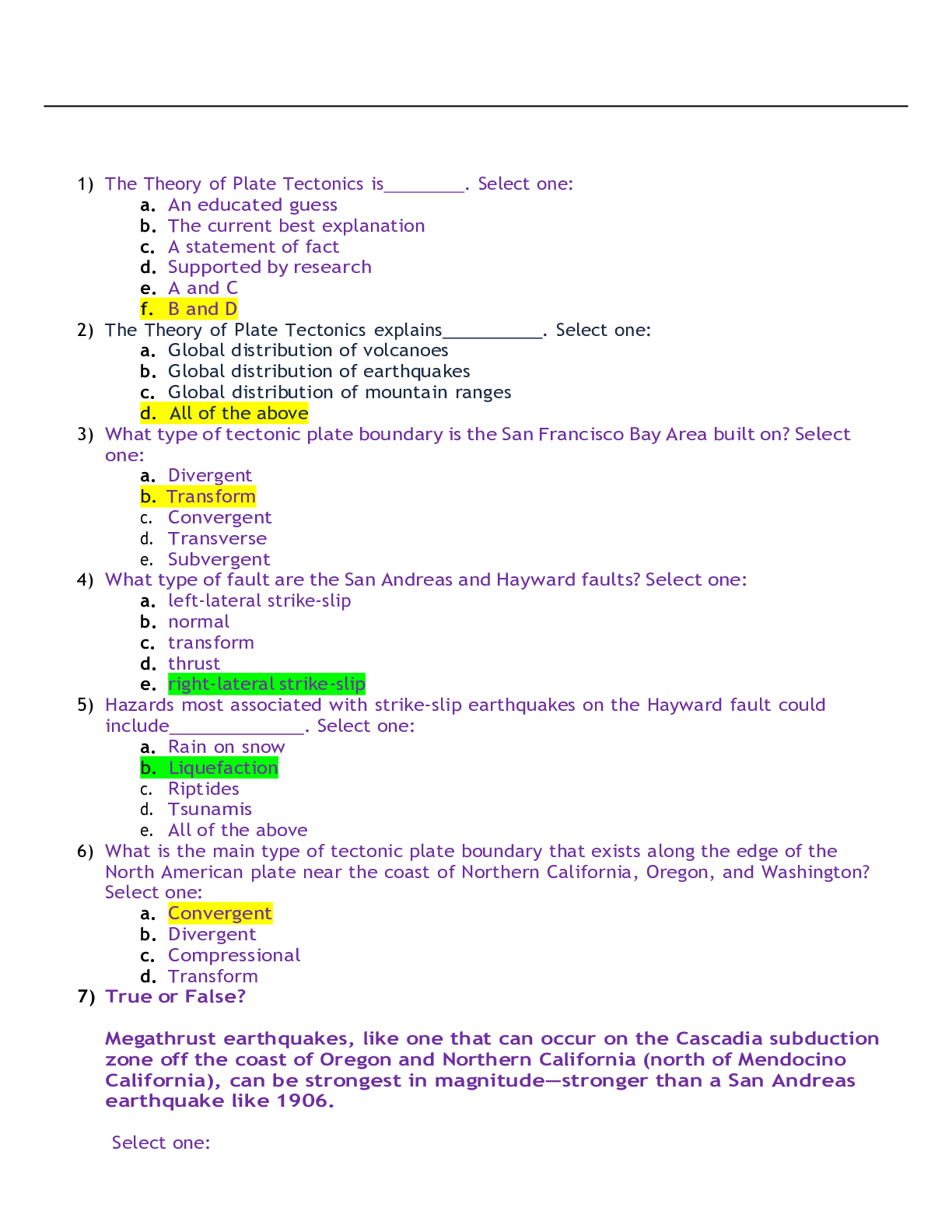*NURSING > EXAM > FUNDAMENTAL PN HESI SPECIALITY V2-MIAMI DADE COLLEGE,MIAMI:ALL ANSWERS ARE CORRECT (All)
FUNDAMENTAL PN HESI SPECIALITY V2-MIAMI DADE COLLEGE,MIAMI:ALL ANSWERS ARE CORRECT
Document Content and Description Below
2017 Fundamental PN Hesi Specialty V2 1) During the initial physical assessment of a newly admitted client with a pressure ulcer, a LPN observes that the client's skin is dry and scaly. The nurse app... lies emollients and reinforces the dressing on the pressure ulcer. Legally, were the nurse's actions adequate? A The nurse also should have instituted a plan to increase activity. B The nurse provided supportive nursing care for the well-being of the client. C Debridement of the pressure ulcer should have been done before the dressing was applied. D Treatment should not have been instituted until the health care provider's prescriptions were received. 2) A visitor comes to the nursing station and tells the nurse that a client and his relative had a fight and that the client is now lying unconscious on the floor. What is the most important action the LPN/LVN needs to take? A Ask the client if he is okay. B Call security from the room. C Find out if there is anyone else in the room. D Ask security to make sure the room is safe 3) To ensure the safety of a client who is receiving a continuous intravenous normal saline infusion, the LPN should change the administration set every: A 4 to 8 hours B 12 to 24 hours C 24 to 48 hours D 72 to 96 hours 4) A LPN/LVN is taking care of a client who has severe back pain as a result of a work injury. What nursing considerations should be made when determining the client's plan of care? Select all that apply. A Ask the client what is the client's acceptable level of pain. B Eliminate all activities that precipitate the pain. C Administer the pain medications regularly around the clock. D Use a different pain scale each time to promote patient education. E Assess the client's pain every 15 minutes 5) The LPN/LVN is preparing to administer eardrops to a client that has impacted cerumen. Before administering the drops, the nurse will assess the client for which contraindications? Select all that apply. A Allergy to the medication B Itching in the ear canal C Drainage from the ear canal D Tympanic membrane rupture E Partial hearing loss in the affected ear 6) What clinical indicators should the LPN/LVN expect a client with hyperkalemia to exhibit? Select all that apply. A Tetany B Seizures C Diarrhea D Weakness E Dysrhythmias 7) A health care provider has prescribed isoniazid (Laniazid) for a client. Which instruction should the LPN give the client about this medication? A Prolonged use can cause dark concentrated urine. B The medication is best absorbed when taken on an empty stomach. C Take the medication with aluminum hydroxide to minimize GI upset. D Drinking alcohol daily can cause drug-induced hepatitis 8) To minimize the side effects of the vincristine (Oncovin) that a client is receiving, what does the LPN/LVN expect the dietary plan to include? A Low in fat B High in iron C High in fluids D Low in residue 9) A postoperative client says to the nurse, "My neighbor, I mean the person in the next room, sings all night and keeps me awake." The neighboring client has dementia and is awaiting transfer to a nursing home. How can the LPN/LVN best handle this situation? A Tell the neighboring client to stop singing. B Close the doors to both clients' rooms at night. C Give the complaining client the prescribed as needed sedative. D Move the neighboring client to a room at the end of the hall 10) The nurse is providing postoperative care to a client who had a submucosal resection (SMR) for a deviated septum. The LPN should monitor for what complication associated with this type of surgery? A Occipital headache B Periorbital crepitus C Expectoration of blood D Changes in vocalization 11) A nurse is reviewing a plan of care for a client who was admitted with dehydration as a result of prolonged watery diarrhea. Which prescription should the LPN/LVN question? A Oral psyllium (Metamucil) B Oral potassium supplement C Parenteral half normal saline D Parenteral albumin (Albuminar) 12) A client is to have mafenide (Sulfamylon) cream applied to burned areas. For which serious side effect of mafenide therapy should the LPN/LVN monitor this client? A Curling ulcer B Renal shutdown C Metabolic acidosis D Hemolysis of red blood cells 13) A LPN is preparing to administer an ophthalmic medication to a client. What techniques should the nurse use for this procedure? Select all that apply. A Clean the eyelid and eyelashes. B Place the dropper against the eyelid. C Apply clean gloves before beginning of procedure. D Instill the solution directly onto cornea. E Press on the nasolacrimal duct after instilling the solution. 14) The LPN/LVN recognizes that which are important components of a neurovascular assessment? Select all that apply. A Orientation B Capillary refill C Pupillary response D Respiratory rate E Pulse and skin temperatureF Movement and sensation 15) A client reaches the point of acceptance during the stages of dying. What response should the LPN/LVN expect the client to exhibit? A Apathy B Euphoria C Detachment D Emotionalism 16) A dying client is coping with feelings regarding impending death. The nurse bases care on the theory of death and dying by Kübler-Ross. During which stage of grieving should the LPN/LVN primarily use nonverbal interventions? A Anger B Denial C Bargaining D Acceptance 17) When a client files a lawsuit against a LPN for malpractice, the client must prove that there is a link between the harm suffered and actions performed by the nurse that were negligent. This is known as: A Evidence B Tort discovery C Proximate causeD Common cause 18) Following a surgery on the neck, the client asks the LPN why the head of the bed is up so high. The LPN should tell the client that the high-Fowler position is preferred for what reason? A To avoid strain on the incision B To promote drainage of the wound C To provide stimulation for the client D To reduce edema at the operative site 19) The LPN is preparing discharge instructions for a client who has begun to demonstrate signs of early Alzheimer dementia. The client lives alone. The client's adult children live nearby. According to the prescribed medication regimen the client is to take medications six times throughout the day. What is the priority nursing intervention to assist the client with taking the medication? A Contact the client's children and ask them to hire a private duty aide who will provide round-the-clock care. B Develop a chart for the client, listing the times the medication should be taken. C Contact the primary health care provider and discuss the possibility of simplifying the medication regimen. D Instruct the client and client's children to put medications in a weekly pill organizer 20) The LPN/LVN expects a client with an elevated temperature to exhibit what indicators of pyrexia? Select all that apply. A Dyspnea B Flushed face C Precordial pain D Increased pulse rate E Increased blood pressure 21) The LPN/LVN should instruct a client with an ileal conduit to empty the collection device frequently because a full urine collection bag may: A Force urine to back up into the kidneys. B Suppress production of urine. C Cause the device to pull away from the skin. D Tear the ileal conduit 22) A LPN is reviewing studies to answer a clinical question as part of an evidence-based practice project. The study design determines the level of evidence. Place each methodology in order from the most reliable to the least reliable. A Meta-analysis B Randomized controlled trial C Expert opinion based on scientific principles D Cohort study E Controlled trial without randomization 23) Client expresses concern about being exposed to radiation therapy because it can cause cancer. What should the LPN emphasize when informing the client about exposure to radiation? A The dosage is kept at a minimum. B Only a small part of the body is irradiated. C The client's physical condition is not a risk factor. D Nutritional environment of the affected cells is a risk factor. 24) The triage LPN in the emergency department receives four clients simultaneously. Which of the clients should the nurse determine can be treated last? A Multipara in active labor B Middle-aged woman with substernal chest pain C Older adult male with a partially amputated finger D Adolescent boy with an oxygen saturation of 91% 25) Health promotion efforts with the chronically ill client should include interventions related to primary prevention. What should this include? A Encouraging daily physical exercise B Performing yearly physical examinations C Providing hypertension screening programs D Teaching a person with diabetes how to prevent complications 26) A LPN/LVN who is working on a medical-surgical unit receives a phone call requesting information about a client who has undergone surgery. The nurse observes that the client requested a do not publish (DNP) order on any information regarding condition or presence in the hospital. What is the best response by the LPN/LVN? A "We have no record of that client on our unit. Thank you for calling." B "The new privacy laws prevent me from providing any client information over the phone." C "The client has requested that no information be given out. You'll need to call the client directly." D "It is against the hospital's policy to provide you with any information regarding any of our clients." 27) When being interviewed for a position as a registered professional LPN, the applicant is asked to identify an example of an intentional tort. What is the appropriate response? A Negligence B Malpractice C Breach of duty D False imprisonment 28) The LPN/LVN plans care for a client with a somatoform disorder based on the understanding that the disorder is: A A physiological response to stress B A conscious defense against anxiety C An intentional attempt to gain attention D An unconscious means of reducing stress 29) A LPN is caring for a client diagnosed with methicillin-resistant Staphylococcus aureus (MRSA) in the urine. The health care provider orders an indwelling urinary catheter to be inserted. Which precaution should the nurse take during this procedure? A Droplet precautions B Reverse isolation C Surgical asepsisD Medical asepsis 30) Alternative therapy measures have become increasingly accepted within the past decade, especially in the relief of pain. Which methods qualify as alternative therapies for pain? Select all that apply. A Prayer B Hypnosis C Medication D Aromatherapy E Guided imagery 31) A LPN is teaching an adolescent about type 1 diabetes and selfcare. Which questions from the client indicate a need for additional teaching in the cognitive domain? Select all that apply. A "What is diabetes?" B "What will my friends think?" C "How do I give myself an injection?" D "Can you tell me how the glucose monitor works?"E"How do I get the insulin from the vial into the syringe? 32) Place each step of the nursing process in the order that it should be used. Correct A Obtain client's nursing history. Correct B State client's nursing needs. Correct C Identify goals for care. Correct D Develop a plan of care. Correct E Implement nursing interventions. 33) In what position should the LPN/LVN place a client recovering from general anesthesia? A Supine B Side-lying C High Fowler E Trendelenburg 34) Which age-related change should the LPN/LVN consider when formulating a plan of care for an older adult? Select all that apply. A Difficulty in swallowing B Increased sensitivity to heat C Increased sensitivity to glare D Diminished sensation of pain E Heightened response to stimuli 35) The spouse of a comatose client who has severe internal bleeding refuses to allow transfusions of whole blood because they are Jehovah's Witnesses. The client does not have a Durable Power of Attorney for Healthcare. What action should the LPN/LVN take? A Institute the prescribed blood transfusion because the client's survival depends on volume replacement. B Clarify the reason why the transfusion is necessary and explain the implications if there is no transfusion. C Phone the health care provider for an administrative prescription to give the transfusion under these circumstances. D Give the spouse a treatment refusal form to sign and notify the health care provider that a court order now can be sought 36) Twenty-four hours after a cesarean birth, a client elects to sign herself and her baby out of the hospital. Staff members are unable to contact her health care provider. The client arrives at the nursery and asks that her infant be given to her to take home. What is the most appropriate nursing action? A Give the infant to the client and instruct her regarding the infant's care. B Explain to the client that she can leave, but her infant must remain in the hospital. C Emphasize to the client that the infant is a minor and legally must remain until prescriptions are received. D Tell the client that hospital policy prevents the staff from releasing the infant until ready for discharge 37) A client reports fatigue and dyspnea and appears pale. The LPN/ LVN questions the client about medications currently being taken. In light of the symptoms, which medication causes the nurse to be most concerned? A Famotidine (Pepcid) B Methyldopa (Aldomet) C Ferrous sulfate (Feosol) D Levothyroxine (Synthroid) 38) The LPN/LVN assesses a client's pulse and documents the strength of the pulse as 3+. The nurse understands that this indicates the pulse is: A faint, barely detectable. B slightly weak, palpable. C normal. D bounding. 39) A toddler screams and cries noisily after parental visits, disturbing all the other children. When the crying is particularly loud and prolonged, the LPN puts the crib in a separate room and closes the door. The toddler is left there until the crying ceases, a matter of 30 or 45 minutes. Legally, how should this behavior be interpreted? A Limits had to be set to control the child's crying. B The child had a right to remain in the room with the other children.C The child had to be removed because the other children needed to be considered. D Segregation of the child for more than half an hour was too long a period of time 40) An older client who is receiving chemotherapy for cancer has severe nausea and vomiting and becomes dehydrated. The client is admitted to the hospital for rehydration therapy. Which interventions have specific gerontologic implications the LPN must consider? Select all that apply. A Assessment of skin turgor B Documentation of vital signs C Assessment of intake and output D Administration of antiemetic drugs E Replacement of fluid and electrolytes 41) What should the LPN/LVN consider when obtaining an informed consent from a 17-year-old adolescent? A If the client is allowed to give consent B The client cannot make informed decisions about health care.C If the client is permitted to give voluntary consent when parents are not available D The client probably will be unable to choose between alternatives when asked to consent 42) Which nursing activities are examples of primary prevention? Select all that apply. A Preventing disabilities B Correcting dietary deficiencies C Establishing goals for rehabilitation D Assisting with immunization program E Stopping smoking 43) An 85-year-old client has just been admitted to a nursing home. When designing a plan of care for this older adult the nurse recalls what expected sensory losses associated with aging? Select all that apply. A Difficulty in swallowing B Diminished sensation of pain C Heightened response to stimuli D Impaired hearing of high-frequency sounds E Increased ability to tolerate environmental heat 44) A nurse receives a subpoena in a court case involving a child. The nurse is preparing to appear in court. In addition to the state Nurse Practice Act and the American Nursing Association (ANA) Code for Nurses, what else should the nurse review? A Nursing's Social Policy Statement B State law regarding protection of minors C ANA Standards of Clinical Nursing Practice D References regarding a child's right to consent 45) A client is receiving albuterol (Proventil) to relieve severe asthma. For which clinical indicators should the LPN monitor the client? Select all that apply. A Tremors B Lethargy C Palpitations D Visual disturbances E Decreased pulse rate 46) A client asks about the purpose of a pulse oximeter. The LPN/LVN explains that it is used to measure the: A Respiratory rate. B Amount of oxygen in the blood. C Percentage of hemoglobin-carrying oxygen. D Amount of carbon dioxide in the blood 47) A client comes to the clinic complaining of a productive cough with copious yellow sputum, fever, and chills for the past two days. The first thing the LPN/LVN should do when caring for this client is to: A Encourage fluids. B Administer oxygen. C Take the temperature. D Collect a sputum specimen 48) A LPN/LVN is preparing a community health program for senior citizens. The nurse teaches the group that the physical findings that are typical in older people include: A A loss of skin elasticity and a decrease in libido B Impaired fat digestion and increased salivary secretions C Increased blood pressure and decreased hormone production D An increase in body warmth and some swallowing difficulties 49) A client has been diagnosed as brain dead. The LPN/LVN understands that this means that the client has: A No spontaneous reflexes B Shallow and slow breathing C No cortical functioning with some reflex breathing D Deep tendon reflexes only and no independent breathing 50) A LPN/LVN cares for a client that has been bitten by a large dog. A bite by a large dog can cause which type of trauma? A Abrasion B Fracture C Crush injury D Incisional laceration 51) A client who was exposed to hepatitis A asks why an injection of gamma globulin is needed. Before responding, what should the LPN consider about how gamma globulin provides passive immunity? A It increases production of short-lived antibodies. B It accelerates antigen-antibody union at the hepatic sites. C The lymphatic system is stimulated to produce antibodies. D The antigen is neutralized by the antibodies that it supplies 52) A LPN is caring for a client with an impaired immune system. Which blood protein associated with the immune system is important for the nurse to consider? A Albumin B Globulin C Thrombin D Hemoglobin 53) A LPN discusses the philosophy of Alcoholics Anonymous (AA) with the client who has a history of alcoholism. What need must selfhelp groups such as AA meet to be successful? A Trust B Growth C Belonging D Independence 54) What type of interview is most appropriate when a LPN/LVN admits a client to a clinic? A Directive B Exploratory C Problem solving D Information giving 55) A client reaches the point of acceptance during the stages of dying. What response should the LPN/LVN expect the client to exhibit? A Apathy B Euphoria C Detachment D Emotionalism [Show More]
Last updated: 1 year ago
Preview 1 out of 17 pages
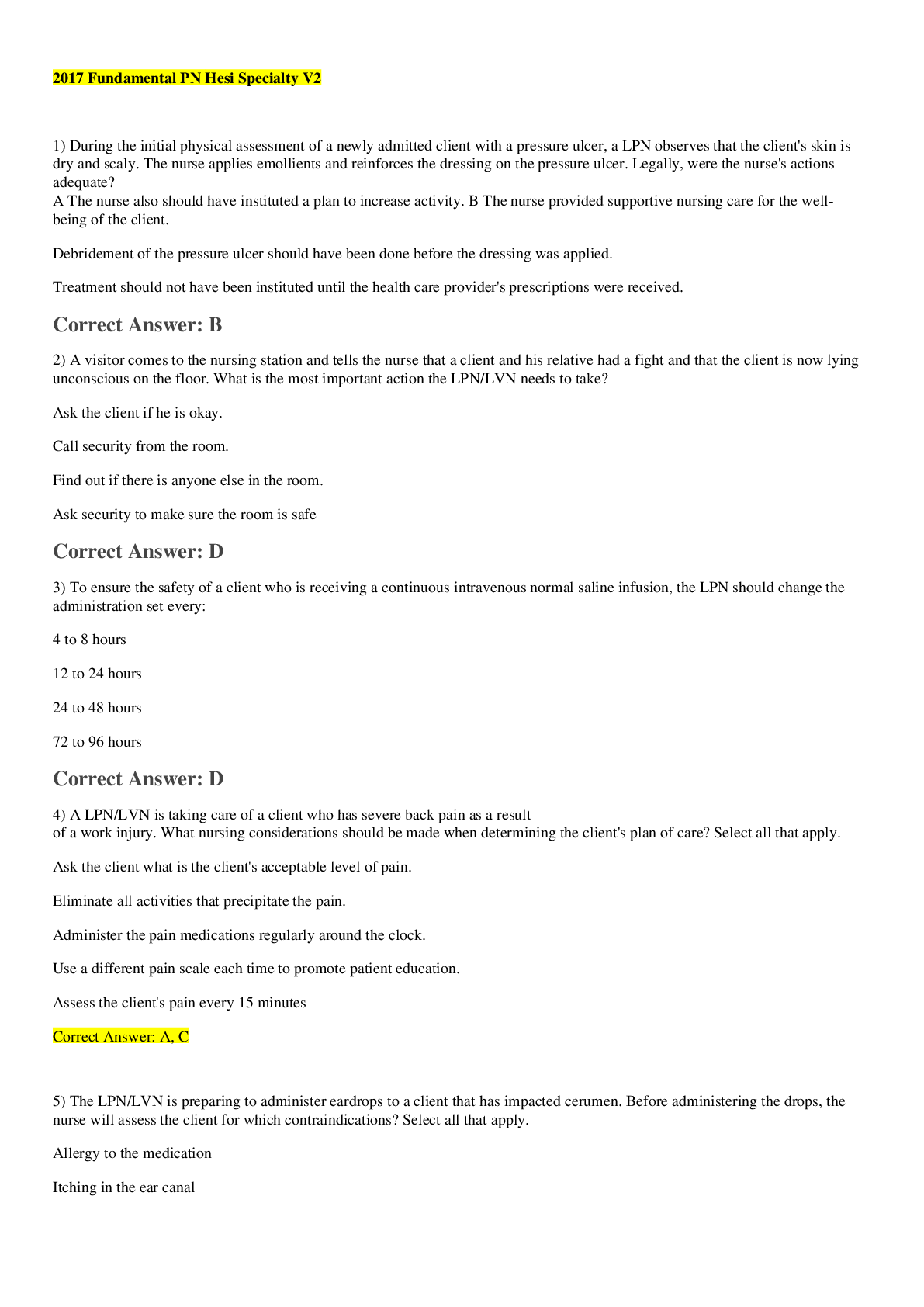
Reviews( 0 )
Document information
Connected school, study & course
About the document
Uploaded On
May 19, 2020
Number of pages
17
Written in
Additional information
This document has been written for:
Uploaded
May 19, 2020
Downloads
0
Views
46

